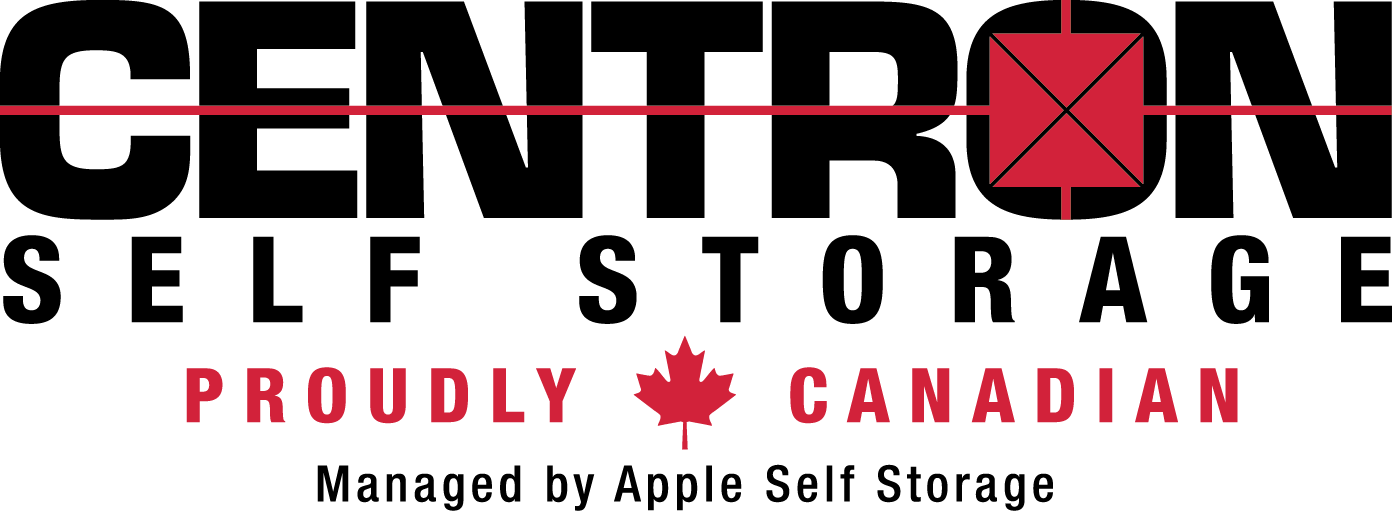How to Declutter Your Storage Unit Like a Pro
People pay for storage rental in North York where they can temporarily store their unused belongings. Eventually, years of usage can fill up your storage unit. Facing boxes full of years’ worth of clutter can be overwhelming. You might even think that you require more storage space to accommodate all your unused possessions. However, you do not need to invest in a larger storage unit. The best solution to your problem is to declutter.
Why You Need to Declutter Your Storage Unit
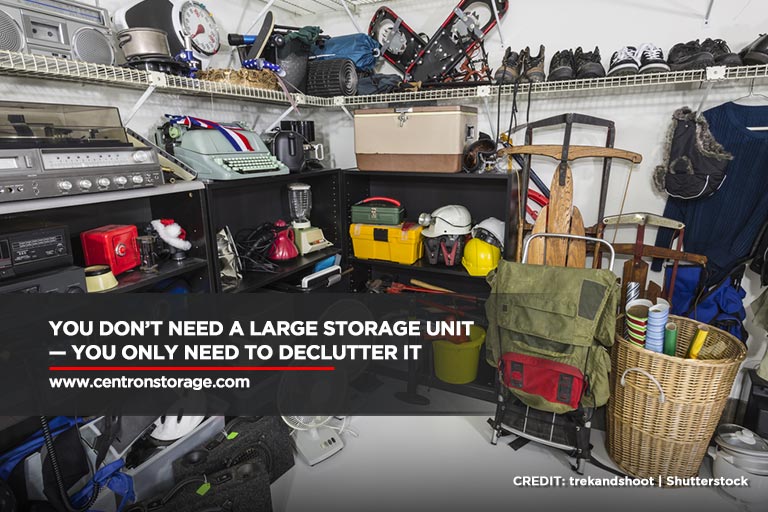
Often, many people only visit their offsite storage units to store excess possessions and forget about them. Since an offsite self-storage unit rental is kept out of sight and out of mind, decluttering may not be high on your priority list. However, the state of your storage room — especially if you haven’t cleaned it in months — can weigh on your mind.
Decluttering your storage unit can give you peace of mind. By doing so, you can rest assured that your unused belongings are safe, organized, and easily accessible the moment you need them. This can make your life easier in many ways. You don’t have to turn the entire place upside down to locate specific items — like a ski boot for your annual winter vacation or some special old memorabilia you need to retrieve. Additionally, having a storage space doesn’t necessarily mean you should store all your possessions — even the damaged, unnecessary ones — just in case you “might” need them again.
When decluttering your rented space, sort through your items and identify which ones to keep, discard, and donate. It will help you free up more space to store items that are truly essential to you.
Tips for Decluttering Your Storage Space Without Feeling Overwhelmed

When the amount of clutter starts to accumulate, it can be impossible to retrieve an important item whenever you need them the most. Not only can this inconvenience you, but years’ of clutter and disorganization can be the biggest hurdle in cleaning up your storage unit. When cleaning feels too daunting, it can paralyze you from making a change. To help you take the first step, we have rounded a checklist to serve as a guide on how to declutter your storage unit in no time.
- Take inventory of your storage unit content
The first step for decluttering your storage unit is scanning and taking immediate stock of its contents.
-
- List down what your see: Start jotting down visible large items. Count the number of boxes and list down what you need to sort through to help you determine the time you need to declutter your unit.
- Make an open space inside or outside the unit: If you have limited space, carve out a free corner as your processing area for the next step. However, if you do not have enough room inside, simply set up a temporary pop-up canopy where you process all your stored belongings outside the unit. However, make sure not to block anyone else’s unit and clean up your mess after.
- Check the contents of the boxes: Once you have organized the boxes, take a look at their contents. This applies to unlabeled boxes. If you see valuable, fragile, or important items, be sure to make quick notes for each box.
Creating a rough inventory before sorting your belongings can give you an idea of what you need to be decluttered and organized.
- Make a plan and enlist the help of your friends or family
After the inventory, you do not need to start right away, especially if you do not have an actionable plan. Knowing the best approach helps eliminate the feeling of being overwhelmed and avoid the most common mistake of storing items in a storage unit. Take time to decide on when to start your decluttering projects.
Prepare what you need to bring—bags, shelves, labels, cleaning tools, boxes and moving supplies. Give yourself enough time to clean and organize your unit. Depending on the size of the job, you might need more than a day of decluttering. If you need to urgently clear out the unit, store items in the boxes or bags so you can easily sort through them in your garage or other location.
- Sort items into categories
When sorting your belongings, prepare 4 boxes and categorize them into the following: “keep”, “store”, “sell/donate”, and “dispose”.
Put all the items you want to bring back home into the “keep” box. For those items that you want to set aside, place them into the “store” box so you can return them to the storage unit. Anything that is in good condition and is no longer needed should be in the “sell/donate” box. Lastly, discard items that are broken beyond repair or those without value in the “dispose” box.
- Clean and organize your unit
If you are done sorting your items, it is time to give your storage unit a clean. After getting rid of dust and debris, organize all the things you need to store in the unit.
-
- Get as many items off the floor if possible. If your rented storage unit comes with shelves, optimize every elevated surface. Items, such as tote bags and seasonal tools can be hung on walls to keep them organized. You can also use small pallets to keep large boxes off the floor to keep them safe.
- To protect your sofa, stuffed chairs, and other furniture from damage, wrap them properly using heavy-duty plastic or specially designed plastic mattress cover.
- Be sure to label boxes by content or purpose. Keep the label facing outward so you can easily read and access them whenever you need.
- Designate a wall for a pegboard or heavy-duty shelf. This allows you to hang your bicycle and organize tools and other important equipment for easy access.
At Centron Self-Storage, we welcome our customers to clean their self-storage units whenever they can, and with your help, we can continue to provide all of you with a clean and well-maintained storage facility where you can safely store all your belongings.
If you are looking for a safe, clean, and secured self-storage in North York, call Centron Self Storage at (416) 739-0000.
12 Tips for Safely Moving Your Items Into Storage
Disassembling large or heavy furniture can help you avoid injury. When doing so, keep all the dismantled parts (such as bolts, screws, or other small pieces) together to prevent confusion when you reassemble the item in your new house. For example, unscrew the legs when moving a table, and extract the draws when moving a desk. If you have furniture prone to scratches like coffee tables, tabletops, and headboards, wrap them in protective padding. You can rent padding from storage facilities or moving companies.
Moving Heavy Objects Safely
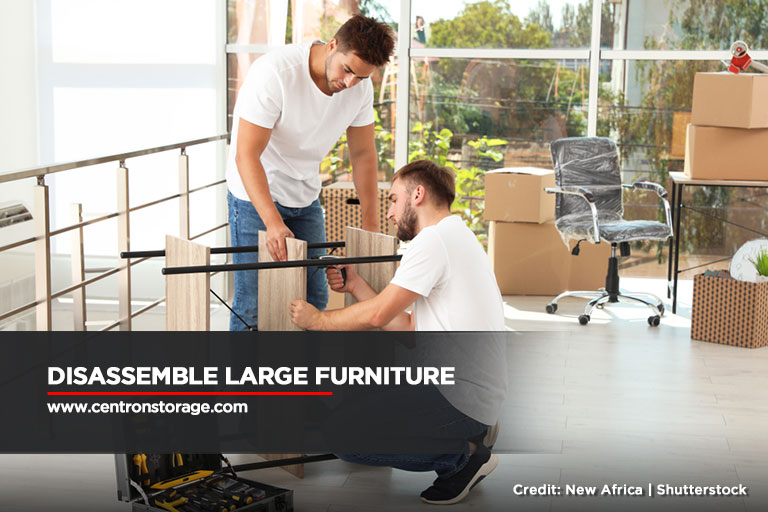
Trying to move boxes that are too heavy will suscept you to injury and potentially damage your belongings. Thus, limit the weight of your boxes to under 50 pounds if possible. Furthermore, make sure you’re putting heavier items at the bottom of the box and lighter items at the top to balance it out.
Moving Fridges Safely
Move the heaviest and largest items first, including the fridge, washing machine, dishwasher, and stove. Additionally, make sure you get a few people to help you with carrying these items. Put the heaviest objects on the sides of the trunk to keep things balanced, and make sure all items are upright. Additionally, items like mirrors, mattresses, box springs, couches, tables, and headboards should go against the longest walls of the trunk. The heaviest and largest boxes should follow this. Fill as many of the truck’s crevices as possible to prevent items from sliding while you are driving.
Find a Truck With a Ramp
If you’re moving your items into the moving truck on your own, you should highly consider getting a truck with a loading ramp. Though the cost of renting a truck without one may be less expensive, the struggle and hassle of lifting every piece of furniture and box high enough to fit it properly into the trunk could leave you with sore and potentially strained muscles. Furthermore, it could take hours.
Use the Correct Size Boxes
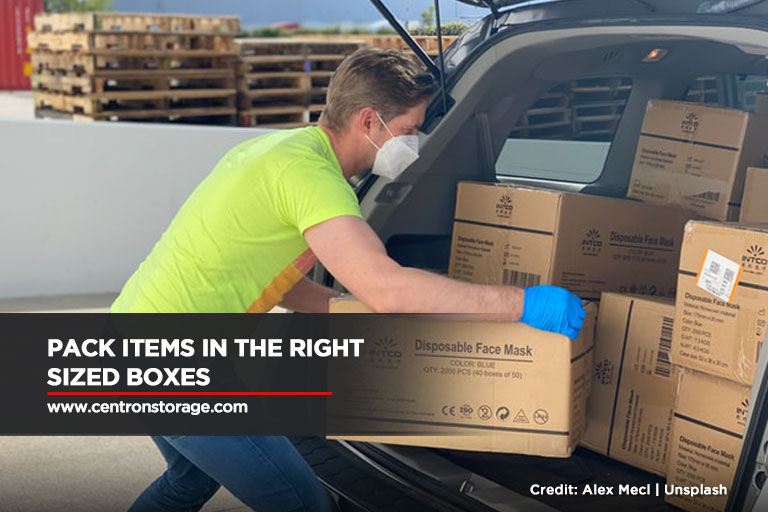
Pack books or other heavy items in small boxes while packing pillows, linen, or other light objects in more giant boxes. Professional movers commonly complain about packing large boxes with heavy items, which makes the job more difficult and are more likely to break. Both of these factors could potentially cause injury to the movers.
Protect Fragile Items
Fragile items should be the last to be put in the trunk and should be placed so that they won’t move while they are being transported. Consider packing fragile items in boxes with light items like linens, clothing, pillows, or towels to provide some cushioning and prevent them from breaking or getting banged up. Alternatively, you could purchase bubble wrap, which will prevent dishes from crashing into each other and is inexpensive.
Pack the Kitchen Carefully
There are many different types of kitchen items you’ll need to pack for a move. Here are some tips for packing your kitchen:
- Cover each dish with packing paper before wrapping them with more paper in bundles of 5 to 6.
- Pack dishes on the side, not flat.
- Use bunched-up paper as padding
- Pack cups and bowls inside each other, putting the paper in between. Then wrap 3-4 in a bundle.
- Pack all dishes in dish-barrel boxes.
- Protect glasses using cardboard dividers, wrapping them in many layers of paper.
Pack Your TV Properly
Plasma TVs need to be packed more carefully than other types of furniture, as they need to be shipped in special wooden crates and be damaged if you don’t have the original box and lay them down flat. If you pack your TV on your own, double-box it and put it inside another box that you have padded using packing paper.
Hold Onto Important Records
Don’t pack your important records into boxes, but keep them in a safe place where they won’t be lost. This may include your:
- Birth certificate
- Social security card
- Passport
- Tax documents
- Chequebooks
- Original copies of wills
- Driver licenses
- Investment papers
Tape Your Boxes Well
Seal the top and bottom seams using a few pieces of tape. Afterward, wrap all the way around the top and bottom edges of the box, as that is where stress is most concentrated. This will keep your items secure and free from damage.
Moving Expensive Art
If you want to keep your artwork safe during the moving process, understanding how to pack it correctly is essential. Don’t wrap oil paintings in normal paper, as they will stick. When packing any artwork, use masking tape to make an X across the glass, strengthening it and keeping it together if it shatters. Afterward, wrap the pictures with bubble wrap or paper before putting them in a frame box. Make sure to also stick cardboard between each framed piece to protect them.
Don’t Leave Empty Space In The Boxes.
Make sure that you fill gaps in your boxes with packing paper or light items like clothing or towels. If your boxes are packed loosely or feel unbalanced, movers might refuse to move them because this can lead to damaged or broken items.
Are you looking for storage near you? Search no further than Centron Self Storage! We ensure that your belongings are being kept safe 24/7, employing fully-trained staff and state-of-the-art technology. Contact us at (416) 739-0000 or visit our office at 4500 Chesswood Drive North York, ON M3J 2B9 if you’re interested in our services.
Gone Fishing! Tips to Store Your Things for Summer
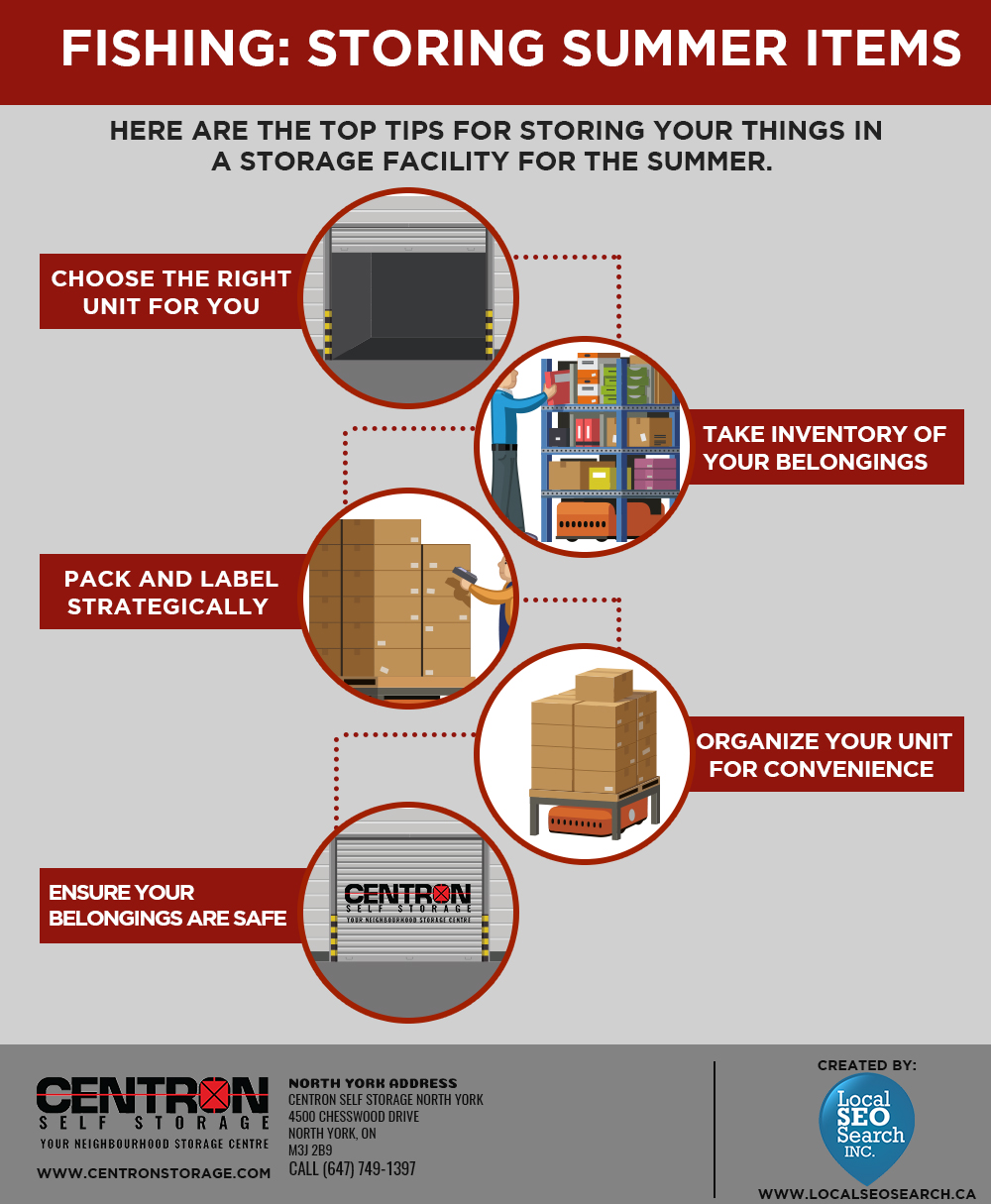
Summer is a time for travel, vacation, and returning home after college exams. If you’re coming back in the fall, why move all your stuff? Take advantage of local storage lockers in North York. Load your items into a personal storage locker over the last few weeks of school, and by the end of exams, you’ll be ready for one final drop-off before the summer break begins.
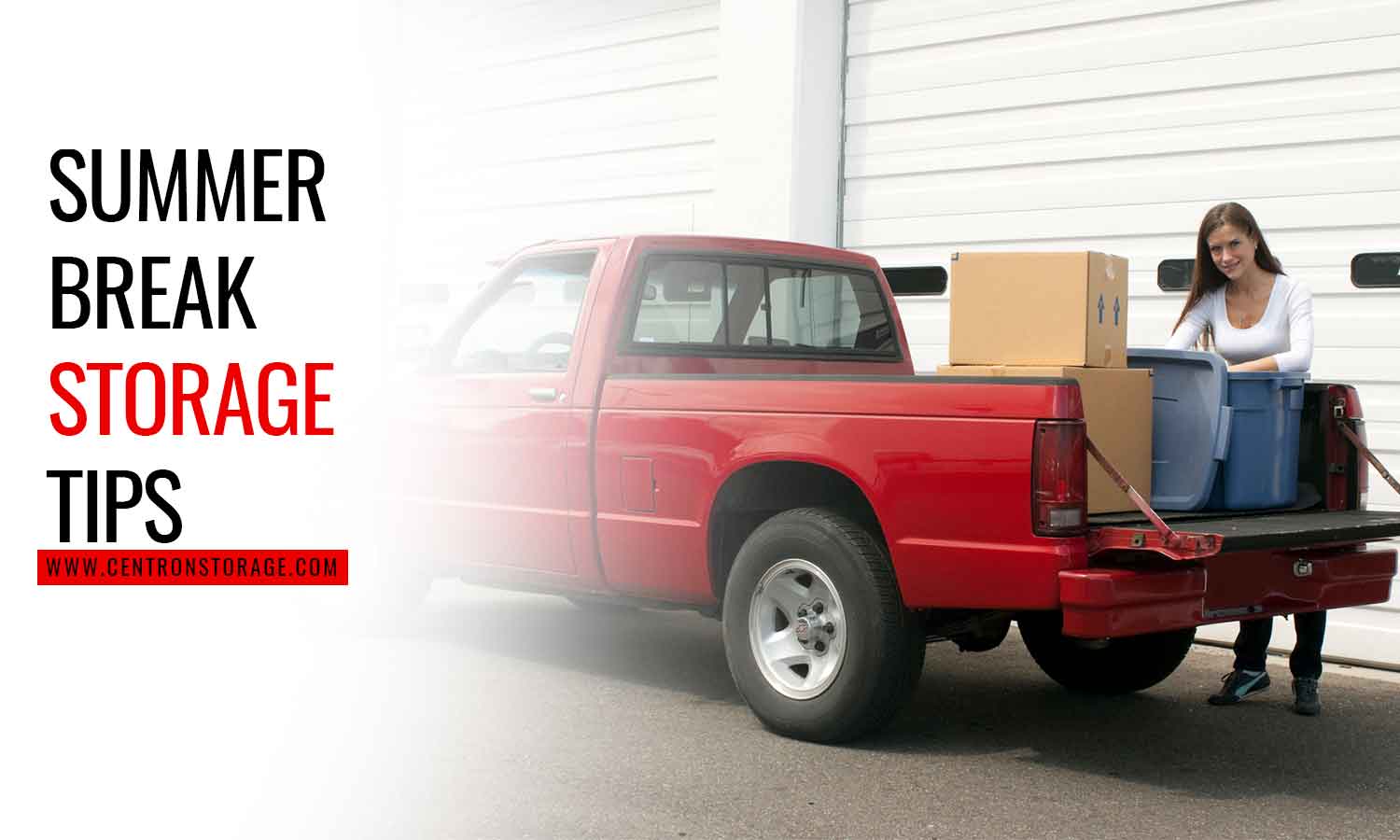
The storage locker you choose matters, as do the ways you store and organize your things. Whether you are a student, vacationing away from home, or need a place to pack away your possessions while renovating, learning the best ways to store your belongings can keep them safe and protected. Here are the top tips for storing your things in a storage facility for the summer.
Choose the Right Unit for You
There are many types and sizes of storage unit options. You want a unit that will comfortably fit all your things with enough room that you can easily access them. If you have valuables that are sensitive to temperature, you might want to look into units that are climate controlled. Prices vary depending on features and locations so keep your budget in mind. If you go to school at York University or one of the other GTA schools, there are plenty of storage options for you. You may want to choose a location that is close to your housing or your dorms to make the transfer faster.

Take Inventory of Your Belongings
Anyone who’s ever lived in a dorm room knows how much stuff you can cram in them. Everyone has a junk drawer and a level of clutter, especially students. You may want to take inventory of your belongings before moving them to a storage locker. Sift out the items to throw out or donate. Remove the things you don’t want or use at least a week or two before moving day. Storing food in a locker is a bad idea, so use them up before the summer or take them home.
After you’ve assessed how much stuff you have, separate what’s going home with you for the summer from what will go into storage. Seasonal and school-related belongings are optimal for storing. You won’t need your desk, school supplies, or winter clothing until next year, for instance. This will make it easier to pack and transport.
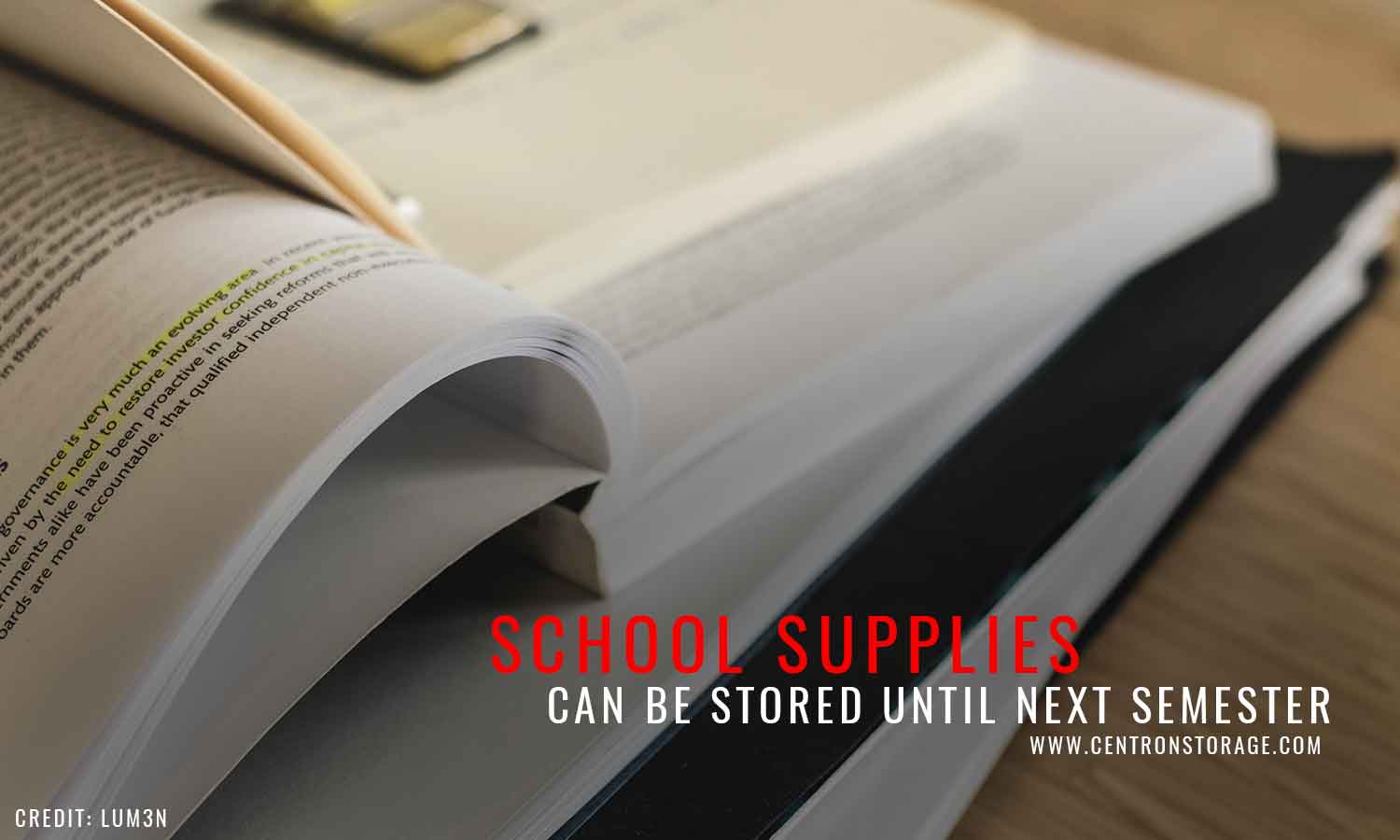
Pack and Label Strategically
You will need some supplies to pack up your things efficiently and store them safely, like fully-labelled boxes, bubble wrap, packing tubes, furniture covers, and so on.
The key to making the transition from your dorm to the storage unit is proper labelling. New moving boxes come with a section on two sides of the box for filling in information. Be detailed about the contents, rather than just specifying the room it goes it. For one, it could be science textbooks and lab supplies. Another could contain dishes, cutlery, or other kitchen supplies. Write clear and concise labels on both sides of each box. Not only will this help you organize your things, it will also be useful if you need to access anything over the summer.
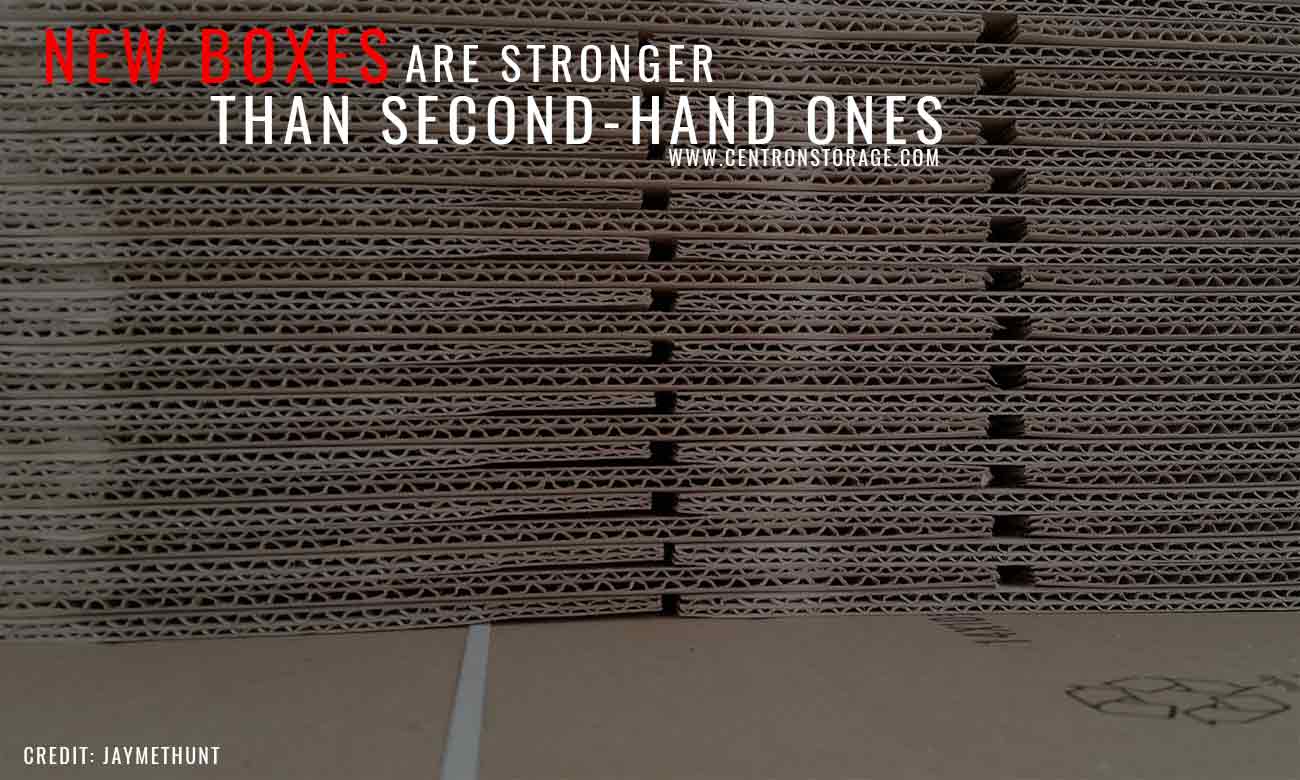
When packing boxes, place heavier items at the bottom. Do not use one box for all of your textbooks because it’ll be cumbersome and difficult to lift. Divide your books into a handful of boxes, perhaps by subject. Use bubble wrap for fragile items. Your dorm room likely had a few posters on the walls to make it feel like home. Use packing tubes to store posters and ensure they don’t get creased or damaged. Cover your desk and other furniture pieces with furniture covers.
Organize Your Unit for Convenience
Once you get to the storage unit, where do you place everything? It can be tempting to stack all your boxes at the back and be done with it. Avoid this strategy. It will make retrieving your goods more difficult when you return. Instead, plan a layout of your storage locker on a piece of paper. Designate different sections for different categories of your belongings. Things you will be less likely to need over the summer, like furniture or winter wear, should be placed in the back of the unit, and things you might want to access, like a bicycle or books you might want to read, stored against the walls towards the front.
Along the walls and in front of more bulky items, stack your boxes with the labels out. You should be able to walk into your unit and see the contents list of each box. On your layout, you can create pathways between the stacks of boxes or categories of items. Then, if you need to get to another box, the aisles you’ve created in your plan will allow you to find it.
Ensure Your Belongings are Safe

When it comes to keeping your stuff safe, choose a reputable storage facility. Look for companies with a good reputation in the community and the reviews to prove it. Word of mouth marketing is often the most reliable, so seek out recommendations from your friends and family. Do your research on the company and check it out in person before reserving a locker, if possible. When visiting the facility, take note of the cleanliness and security of the facility. Can people freely access storage units? How are they sealed and locked?
Most highly-secure storage facilities will give you an identification code to access your unit. No more locks and keys to lose. Remember your code and record it in a safe place. It’s best not to share that code with anyone. For extra protection, consider getting additional tenant insurance for your belongings.
Established and respected storage facilities, like Centron Self Storage, will make you feel welcome and safe. The employees will answer all your questions and go above and beyond to ensure you’re taken care of. Their locations all have electronic gate controls, surveillance cameras, and heavy-duty fences. Facilities are regularly inspected and cleaned.
Customers are the backbone of every company. Storage facilities that acknowledge this will take the best care of you and your things.

Centron Self Storage has been providing clean and secure storage units for over 25 years. When you need a storage locker in North York, our professional consultants can help you choose the right fit for your needs. We use top of the line security to keep your belongings safe, secure, and protected. Whether you’re going home for summer break or away on vacation, Centron can keep your things safe. To reserve a locker, send us a message or call us in North York at (416) 739-0000.
Moving Tips for First Time Home Buyers

You’re excited and likely a little nervous. You’re finally becoming a homeowner, but moving day is approaching, and it can be stressful! You have to pack up all your belongings, transport them, and then unpack them into your new home. Luckily, it doesn’t have to be as scary as it seems. There are many tips for new home owners to make the process smoother and stress-free.
Make this day as enjoyable as possible with these ideas:
Rent a Storage Unit
The timeline is one of the most significant sources of stress when moving. Often there is only a small window to move out of your old home and into the new one. Renting a self-storage unit in North York allows you to buy extra time to make your move less stressful. You’ll be able to temporarily store your belongings in a secure location, reducing the amount of work you have to do on moving day.
Take time to declutter before the move. Go through each room and decide what you want to keep, store, and discard.
Get the Right Supplies
For a smooth move, you need the right equipment. That includes boxes, packing tape, and labels. You should also have a few markers for labelling as well. If you are moving your existing furniture to the new place, consider using furniture covers. They prevent your items from getting scratched or damaged in the transition. For your breakable goods like plates and wine glasses, use bubble wrap and paper wrap.

To save money on moving supplies, consider using what you already have. You can pack your belongings in suitcases and luggage. Dresser drawers can be pulled out and loaded with items. Borrow supplies from friends and family. Local businesses will frequently let you have their used cardboard boxes. When packing, bear in mind that older boxes may be less sturdy than new ones.
Decide What’s Going in Storage
If you do decide to use a storage unit to aid in your move, determine what will go in it. If you’re moving in the summer, you don’t need your winter gear (like toboggans, snow tires, and shovels). Other items that you don’t use frequently can also be stored, like your DVD collection, fancy china dish set, or some of your kids’ toys. Sentimental items can also be stored before your move to make the day go smoother. Memory boxes, picture frames, and heirlooms can all be packed away with care to be kept safe in the unit while you move.
By storing some belongings in advance, you decrease your workload on the big day. As you unpack in the new house and settle in, you can bring those belongings over from the storage unit at your leisure.
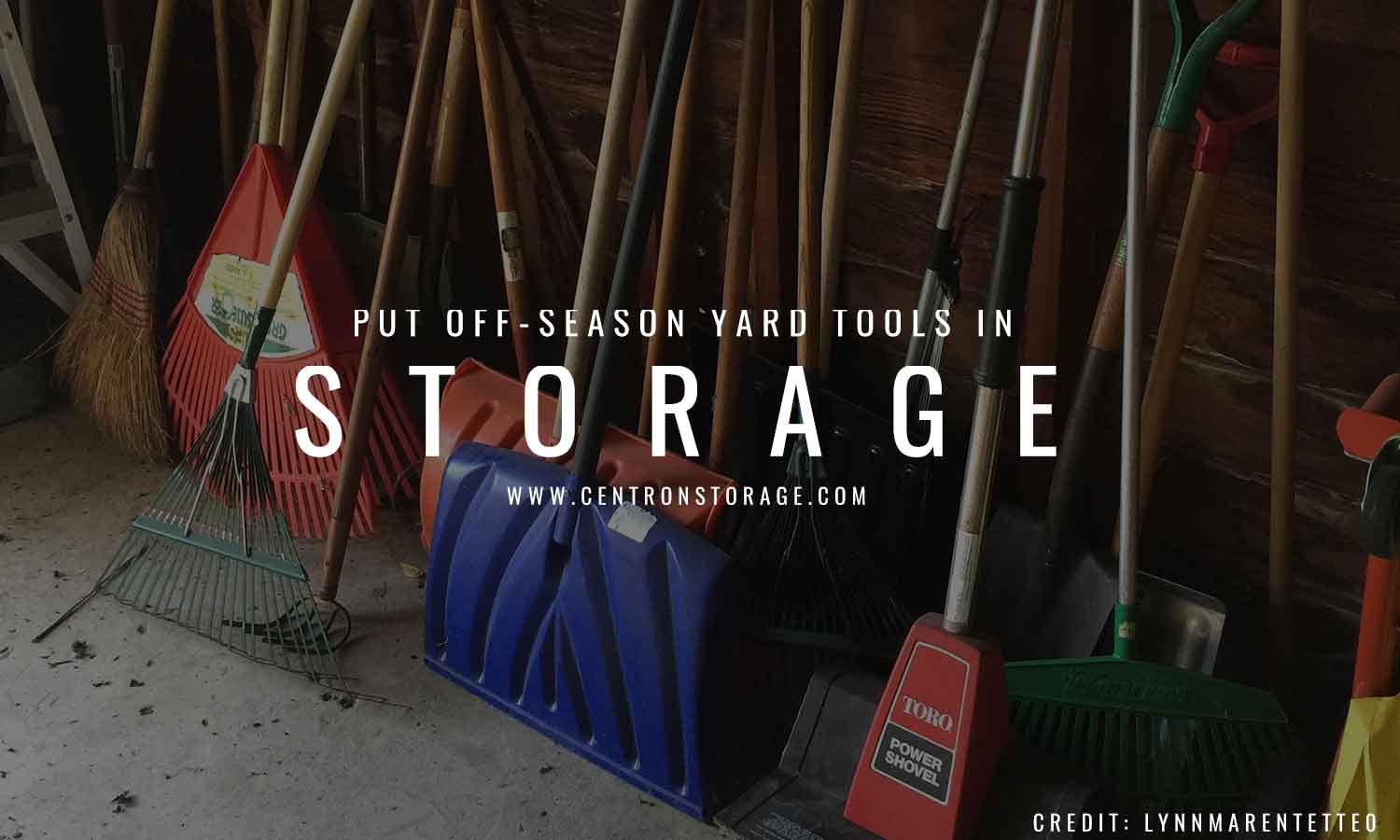
Plan Your Storage Unit Layout
This step will make staying organized so much easier. It starts with knowing your storage unit measurements and drawing a diagram on a piece of paper. You want to create a layout for where you’ll place different boxes and items. For example, things you know you won’t need immediately, like winter supplies, could go in the very back. On your diagram, block out a section for these things. Then, organize the layout by room. Kitchen boxes and items go in one area, living room boxes in another. Make sure you create a pathway between storage sections for easy access.
Renting a storage unit is all about convenience. Planning out your unit will help keep your belongings safe and accessible whenever you want them.
Pack Your Boxes Smartly
It might be tempting to fill the boxes from bottom to top, slap on some tape, and be done with it. However, there’s a better way to pack to make moving a less stressful event.
Start by creating a system. Label each box with the room it will be unpacked in. Then, make a brief list of the items inside. This helps you to know the priority level of the contents. Is it something you’ll need the day after you move, or can it wait for a week before you unpack it? Label at least two sides of the box so you can easily see where it goes. Also, consider purchasing “fragile” stickers. This will save you writing on each one. To save more time, you could even type up your labels and print them onto sticker paper. Make sure the font is large, bold, and clear.
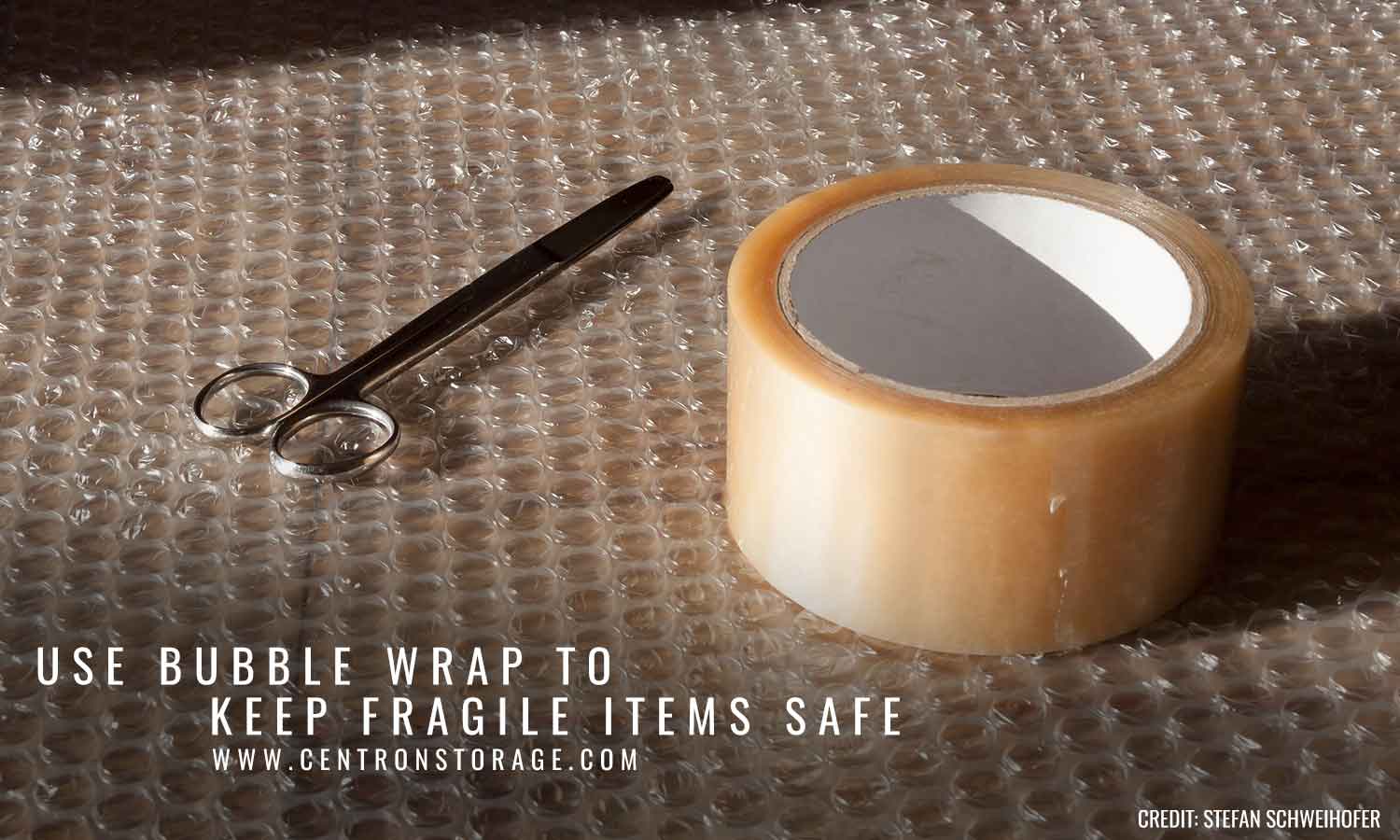
Pack fragile possessions well, but avoid cramming too many into a box. Consider buying a roll of newsprint paper or bubble wrap. Roll each delicate item in bubble wrap or paper, then place in the box. Put some more bubble wrap or paper around each piece to act as a buffer, preventing shifting. Be conscious of the weight of the box. Lighter boxes are easier to carry.
Efficiently Load the Truck
If you hire a moving company to help with your move, their professionals will know the best way to load the truck for optimal unpacking. However, if you’re doing the move yourself, there are some things you should know.
Start with the bulkiest, hardest to move items. Move these items when your energy is at its highest, and you have assistance from friends or family. Next, pack your high-priority boxes. Organize the boxes as you would in the storage unit, by room and priority. If you’ve hired a moving service, storing some of your belongings in advance will reduce the number of hours you have to pay them for, and thus save you money.
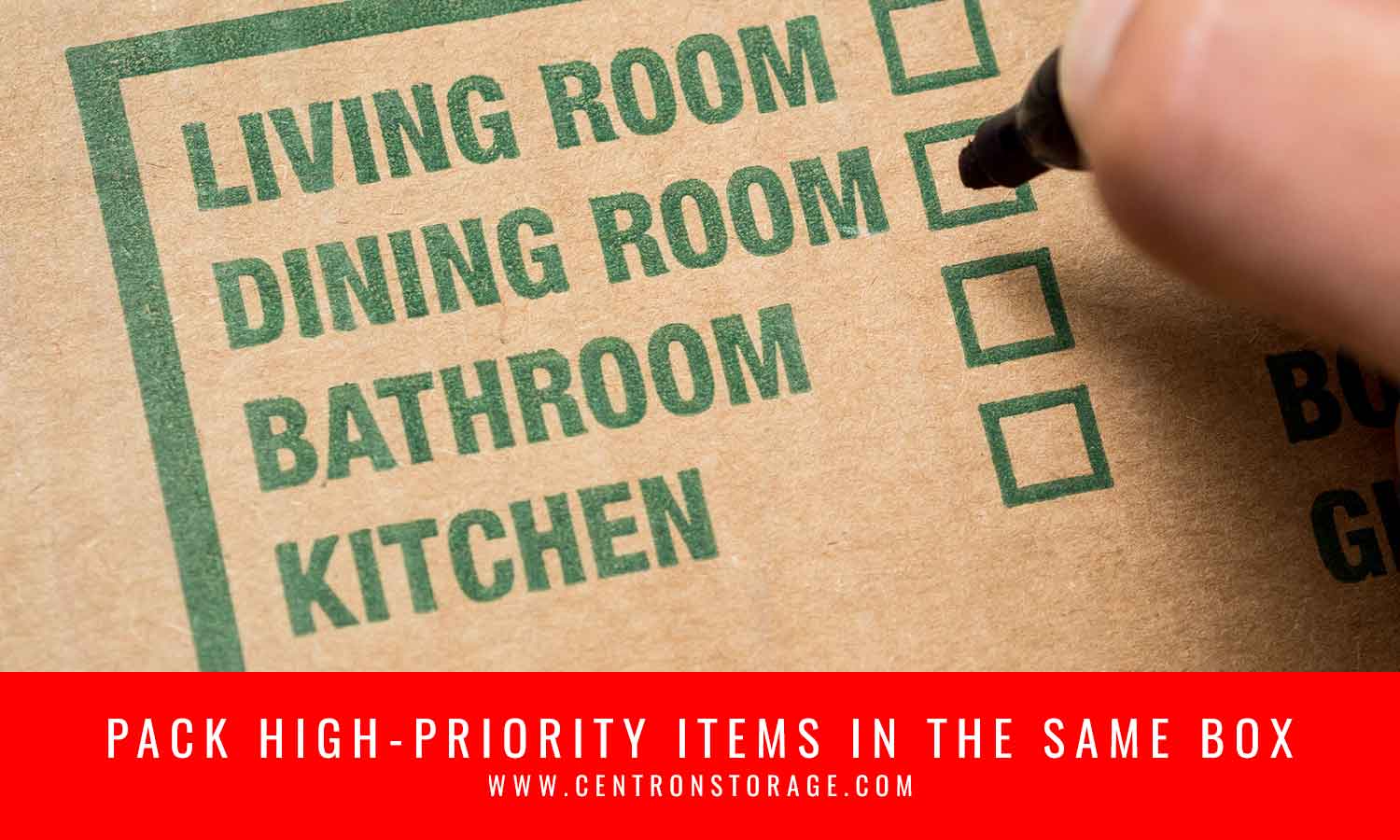
Prepare a Moving Day Essentials Kit
You can make the big day run smooth and stress-free by preparing a moving day essentials kit. In one open box, include the things you know you’ll need on moving day. This could include cleaning supplies, tape, labels, markers, and a change of clothing. You might also include dishes, cups, and cutlery for your family to use before unpacking. If you have children, pack snacks and diaper-changing supplies if necessary. Make sure you have your essential toiletries accessible (like your toothbrush, toothpaste, deodorant, etc.). Any medications or vitamins you and your family need should be in your essentials kit.
By preparing this kit, you will reduce the stress of needing items that might have gotten lost in the move. Everything you will need is in one place.

Centron Storage has provided secure, clean, and reliable storage services for over 25 years. Residents of North York trust us to store their belongings and provide customized service. Whether you need assistance choosing the right unit size for your needs, or finding high-quality moving supplies (like new cardboard boxes at 10 percent off), we’re here to help. To reserve a storage space, send us a message or call us: Centron North York at(416) 739-0000.
Additional Tips for Winter Car Storage
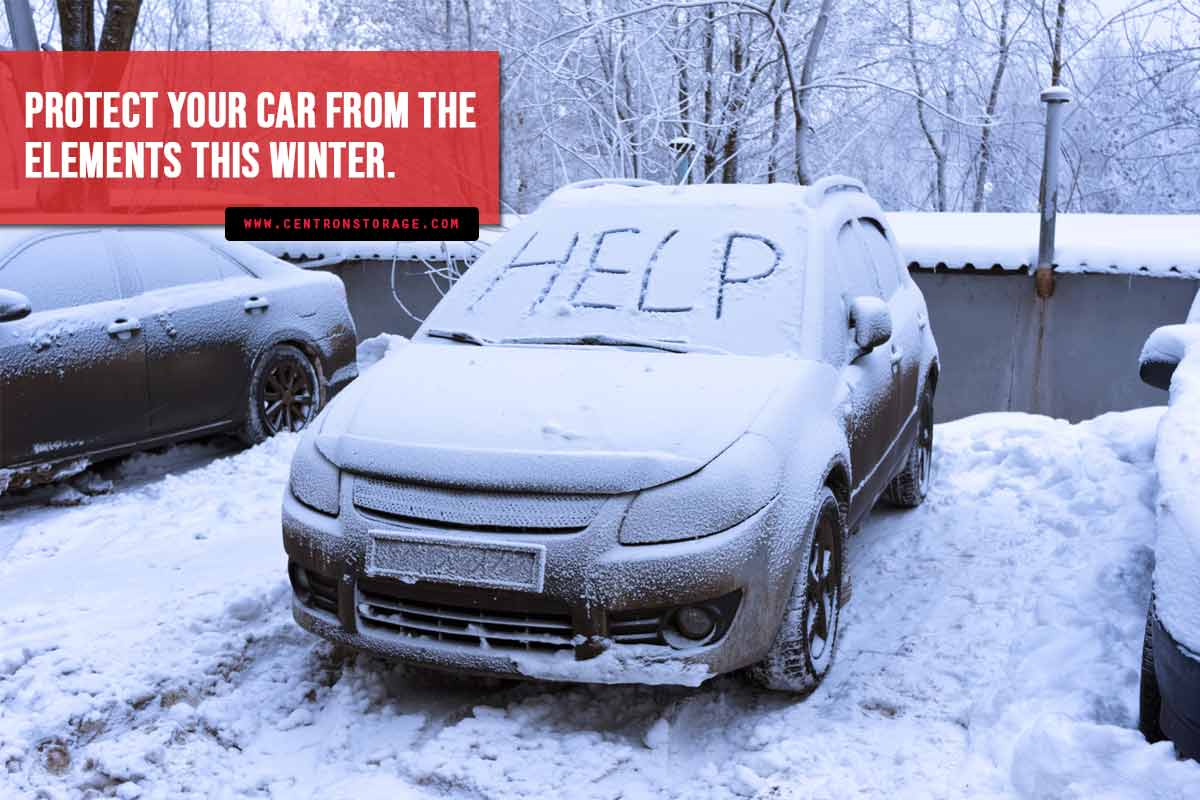
For some drivers, storing their car during the winter is a smart investment; it can protect the vehicle from harsh weather conditions. The chilly winter air can damage many of your car’s components. Although we touched on this subject a few months ago, we want to provide even more in-depth information about why keeping your car out of the rust-inducing salt, slush, and sludge might be a smart move.
Storing your ride does not simply mean parking it inside a safe, warm space until springtime. There are important steps you need to take to keep your vehicle in pristine condition while it is safely kept in storage. Here are some quick tips to get your car ready for wintertime hibernation.
- Park it in a dry, clean area – If you do not have extra space in your garage, do not leave your vehicle outside. Renting a storage unit ensures it will be protected from inclement weather. This can be a worthwhile investment.
A good storage facility must have concrete flooring. It must also be dry, clean, and properly maintained to prevent condensation buildup. The space does not necessarily have to be climate-controlled, but that can certainly help your car during the subzero temperatures.
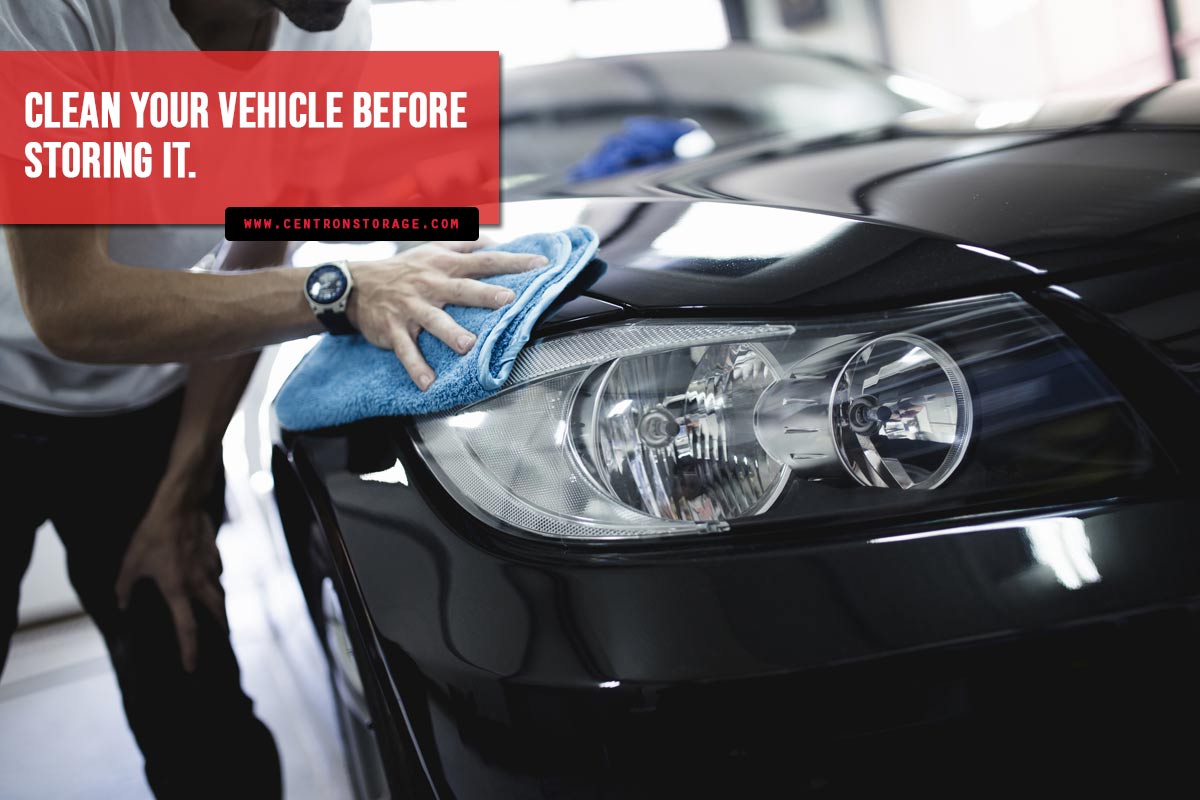
- Clean it thoroughly – Clean your vehicle properly before putting it into storage. Hand washing and waxing protect your vehicle from corrosion and damage to the paint. Wash the undercarriage, fenders, and wheel wells to remove dirt and grease. Minor water stains can permanently damage paint jobs, so be sure to completely dry your car after washing.
Roll up the windows and place boxes of baking soda in the trunk, glove compartment, and cabin to prevent a musty odour from developing while your car is safely tucked away for the winter.
- Keep the pests away – After cleaning and drying the vehicle, take steps to repel pests — especially if you opt to place your car in your home’s garage, rather than a storage facility. Insects and animals seek a safe and warm place to settle during colder weather.
Close doors and windows tightly. Wrap or stuff steel wool inside the air intakes and exhaust to prevent critters from crawling inside. Avoid pushing the wool too far in; you will want to easily pull it out again come spring. Placing mothballs nearby can provide an extra layer of pest control.
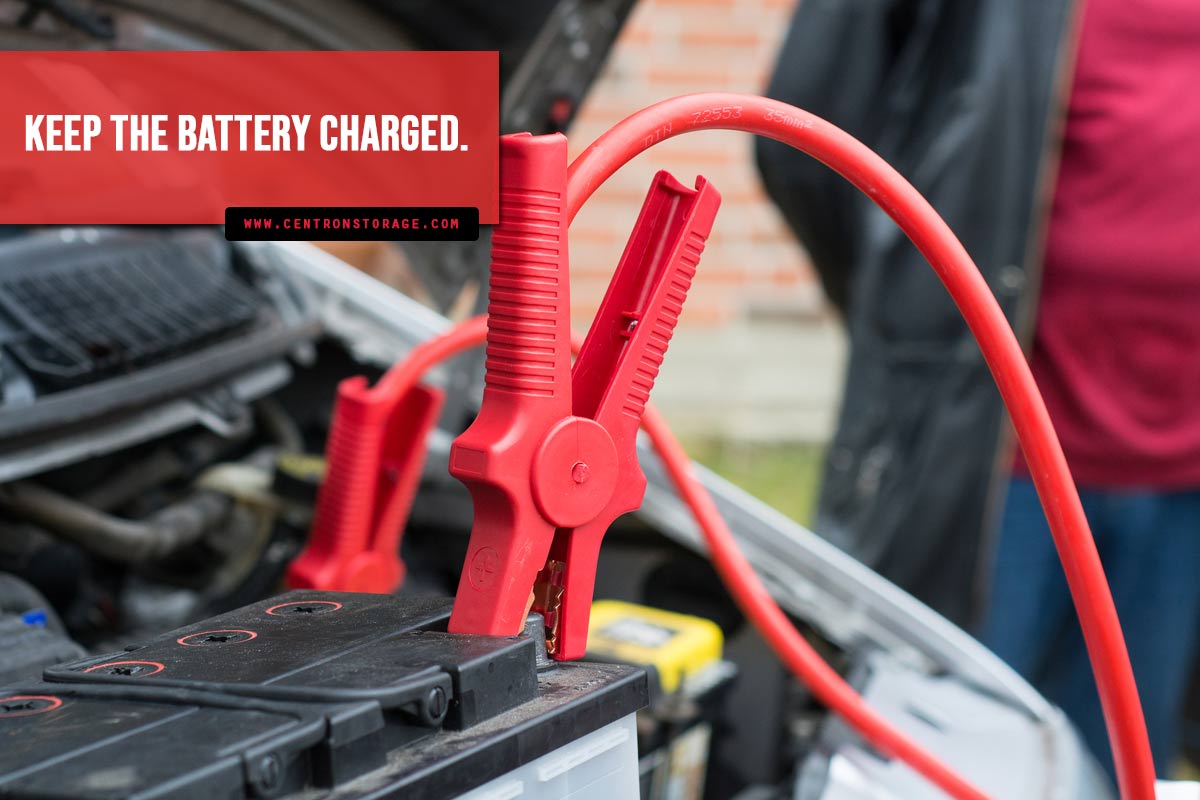
- Keep the battery charged – Improperly storing your battery could reduce its lifespan. A complete discharge, especially in winter, could result in permanent damage to its cells. The best option is to periodically run the engine. This will keep it fully charged and recirculate the fluids.
If you cannot let your engine run where the car is stored, there are other options for protecting your battery. A trickle charger or a battery tender can prevent full discharge. Wherever you store your vehicle, leave it attached to one of these options. They should have an automatic shutoff feature to prevent overcharging.
You could also remove the battery and store it separately. If you store the battery away from the automobile, keep it elevated rather than in contact with the concrete floor.
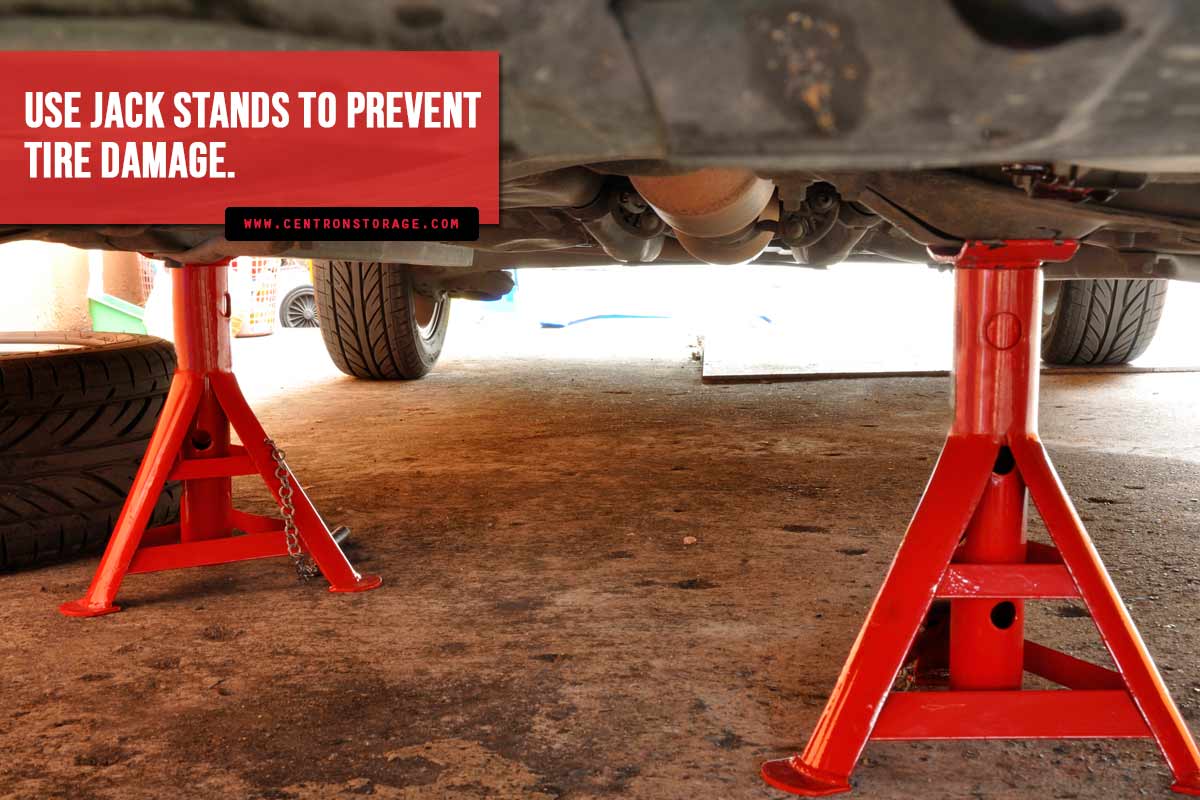
- Prop it up – Letting your vehicle sit for a long time can cause damage to tires. To protect them, rest the car on jack stands rated for its GVW (gross vehicle weight). Place wheel chocks behind the tires and loosen the lug nuts (without removing them). Using a floor jack, raise one end of the vehicle, and place at least two jack stands under the car’s safe lift points.
Once the stands are in place, slowly lower your car to let it rest on them. Repeat this process on the other end of the vehicle. When it is firmly resting on the jack stands, remove the lug nuts and take off the wheels. Store the tires in your garage or basement.
- Avoid using parking brakes – If jack stands are not an option, do not use the parking brake to prevent the parked vehicle from rolling. This could cause stress to brake pads (potentially fusing the pads to the rotors or snapping the brake cables). Instead, place tire chocks behind the wheels, in the direction of the floor’s slope.
- Top up the tank – Completely top up the fuel tank to prevent condensation and keep internal seals lubricated. Fuel stabilizers prevent corrosion in the fuel system and help keep the gas fresh for up to a year.
Change fluids and the oil filter. Ensure you have enough antifreeze to protect mechanical components and fluids from freezing. Run the engine to thoroughly circulate the fluids before storing your car for several months.
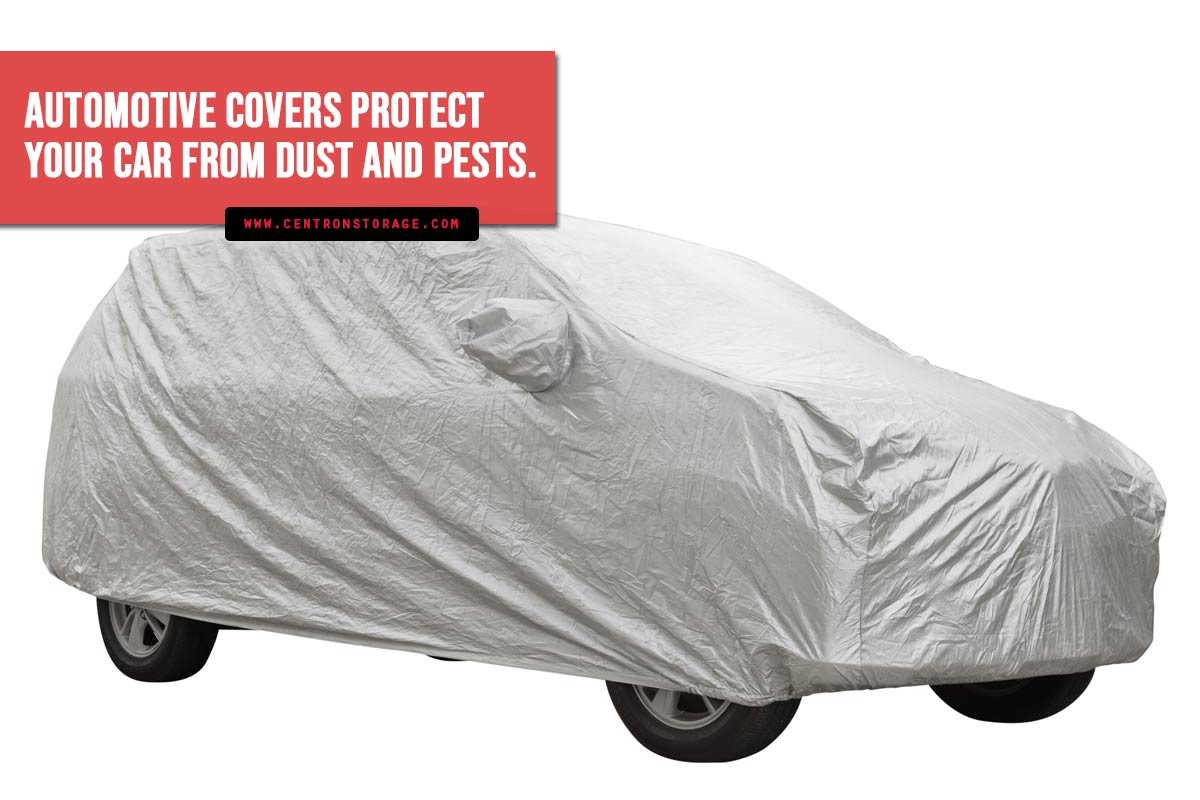
- Tuck and cover – Even when storing your automobile in a secure storage facility, investing in a quality car cover is a good idea. Do not use a plastic tarp — it can scratch the paint job. A proper cover prevents dust and dirt from accumulating on your vehicle’s freshly waxed exterior and can act as protective padding.
A high-quality, breathable, model-specific cover works best to prevent moisture buildup, but a universal cover is likewise better than a bed sheet or tarpaulin. Custom-fitted and universal automotive covers can be bought at most auto parts stores, online or in person.
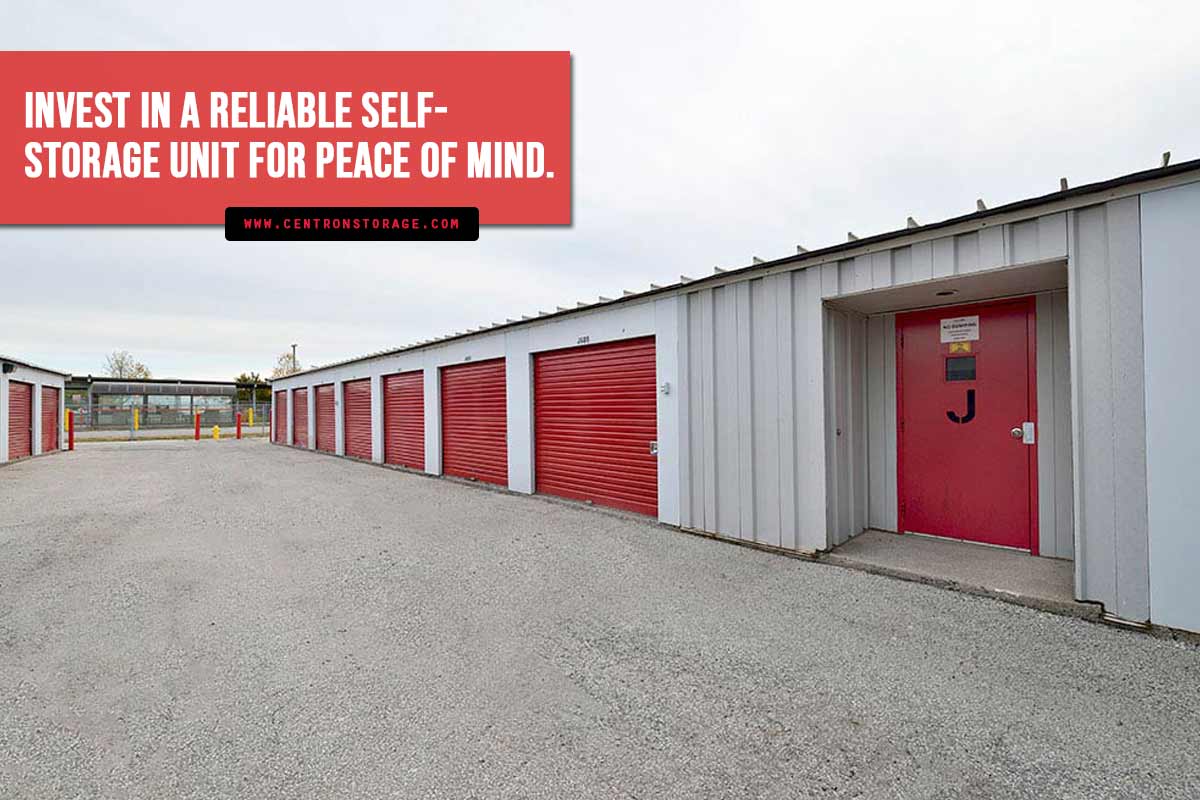
A self-storage facility can be a brilliant winter storage solution. Knowing what to look for in a self-storage unit will help you make the right decision for your car. Here are a few points to keep in mind:
- Superior Service – The staff should be friendly, ready to help, polite, and knowledgeable.
- Security – The venue should be equipped with 24/7 modern security features (surveillance system, gate, fence, security personnel, fire alarms, etc.) for your peace of mind.
- Excellent Overall Condition – The property should be properly maintained. Check that:
- Storage units are in good shape
- Premises are clean
- There are loading docks for cars and trucks
- Parking is convenient
- The location is easily accessible
- The lighting system provides adequate coverage
By taking the time to research your options, you will be better able to find the perfect storage options to keep your car throughout the winter season.
Centron Self Storage provides secure, affordable storage units in North York. We have state-of-the-art facilities, a variety of storage unit sizes, and incredible staff to assist with your needs and keep your valuable possessions safe 24/7. Use our storage calculator to determine the exact size of the unit you need.
Call Centron Self-Storage in North York at (416) 739-0000. We often have a discount offering the first four weeks’ free on select units.
Six Tips to Create Peaceful Energy in Your Home
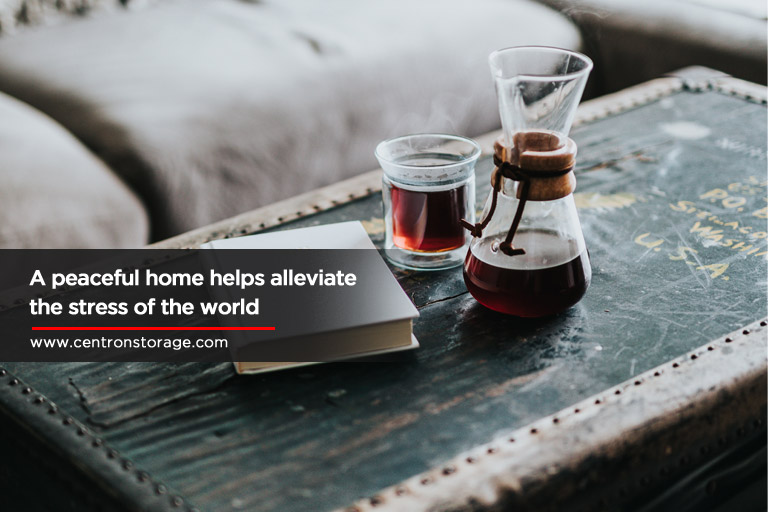
Let’s face it—we live in stressful times where uncertainty rules and the news isn’t always good. What we need is a place where we can find peace—an oasis of calm in a tumultuous world. How do we create peaceful energy in our own homes?
Numerous studies reinforce the idea that a serene and beautiful living space has a direct and positive influence on our mood and psychological health. The ancient Chinese practice of feng shui reinforces the importance of aligning a structure’s energy so as to create harmony for those who live there. Many people feel their mood lift when their homes are even marginally tidier and more organized.
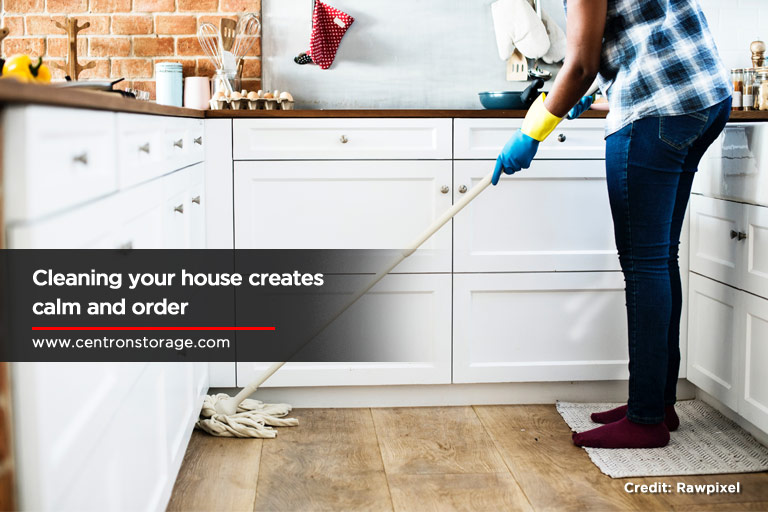
Achieving calm, soothing energy in your home doesn’t need to involve taking down walls to allow the chi (life force or energy) to flow. A few simple steps can go a long way to open your space to more “positive forces.” Here are six tips for doing so:
- Clean the House: This might seem obvious, but there’s something about a good cleaning that helps put the whole picture into perspective. Extra steps at the cleaning stage will help with the next important one, so take a garbage bag or a box and walk through your house. Collect 20 things that no longer serve you. Minimalists do a good job at keeping clutter to a minimum , but if this way of living is too austere for you, first try reducing the overall amount of stuff in your house. Once you’ve collected everything, decide what to do with it: donate, recycle, sell, store, or toss it.
- Store Your Belongings: Regardless of the size of your house, you’ll almost always have furniture, bins of unused toys, extra dishes that were given to you by your great-aunt…you get the idea. Some of these items may have sentimental value or you’re planning to hand them down to the kids. Whatever the reason, keeping your belongings in a self-storage unit is a great solution . It’s safe, secure, and there’s no need to part with something that you’ll later come to miss.
Now that you’ve cleaned and decluttered, it’s time for the fun part. This is where you can be creative and personalize your oasis to create a quiet, stress-free home that will soothe an overwrought soul.

- Add Plants: Not only are plants beautiful to look at, they also play a role in creating a tranquil environment. Studies prove that plants reduce stress and add to an overall feeling of well-being. They improve air quality by reducing carbon dioxide levels, increasing humidity, and reducing certain pollutants and airborne dust levels. Furthermore, plants reduce both indoor and outdoor noise. Numerous studies have linked noise pollution to increasing stress and anxiety levels. Plants are capable of absorbing and reflecting that noise, potentially making life more peaceful.

- Try Aromatherapy: The use of essential oils and other lovely-smelling goodies (like patchouli) has been around for millennia. Ancient civilizations recognized the benefits of aromatic plants for healing, sacred ceremonies, and achieving a higher plane of consciousness. Research shows that certain smells can have a positive effect on our mood. In fact, studies have proven the efficacy of essential oils in helping to relieve depression . With a variety of diffusers from which to choose, aromatherapy can make your sacred space relaxing and pleasant-smelling. Here are several fragrant suggestions to try:
-
- Lavender Oil : Slows the activity of the central nervous system, improves sleep quality, and promotes concentration.
-
- Eucalyptus Oil: Boosts cognitive performance and reduces headaches when combined with peppermint oil. Inhaling steam with a few drop of eucalyptus oil added to it acts as an expectorant and helps alleviate cough and congestion. This essential oil is also effective against certain bacterial strains and is antimicrobial, insecticidal, acaricidal (kills ticks and mites), and nematicidal (kills nematodes) .
-
- Peppermint Oil: Relieves nausea, headaches, upset stomach, and anxiety.
-
- Blue Chamomile Oil: Inhaling chamomile essential oil has a mildly sedative effect on the brain and makes you feel pleasantly sleepy. It also offers a mild anti-anxiety effect for those suffering from generalized anxiety disorder.
-
- Rose Oil: Promotes a quiet mood and can also fight harmful organisms.
-
- Jasmine Oil: Unlike other oils, jasmine has a stimulating effect on your mood and increases alertness, breathing rate, and vigor, promoting an uplifted mood and improved sense of well-being.
-
- Bergamot Oil: Reduces anxiety and has a positive effect on mood.
-
- Lemon Balm Oil: Appears to sharpen memory and boost problem-solving abilities. There is some promising research into the benefits of lemon balm for those with Alzheimer’s disease.
- Plug in a Himalayan Salt Lamp: Science shows that our mood is elevated when we look at something considered beautiful, and a Himalayan salt lamp is just that. Its pinkish/amber color emits a soft, appealing light that can enhance the peaceful nature of your home. While the jury is still out on its supposed health benefits, these lamps are a lovely addition to any sanctuary.

- Play Music: Neuroscientists have identified four ways in which music positively affects our mood:
- Emotion: It’s easy to see how music affects our emotions . Some songs cause tears, others make us want to get up and dance; others simply lull us to sleep. Therapists use music to help those with autism and PTSD, and music causes the brain to release the hormone oxytocin, which stimulates the “cuddle response.” Playing music at home makes us feel cozy and content.
- Memory: Science has proven that music can stimulate memories that are connected to certain songs. Curating a playlist with positive memory associations can create a pleasant atmosphere and evoke joy.
- Learning and Neuroplasticity: Music has been shown to map new neural pathways in the brain and expand neural networks. It also helps injured brains heal and build new ways to process information.
- Attention: Certain types of music can help focus our attention to the task at hand. Research shows that peak attention happens during silences in music, meaning that our brains are more focused; the silences simply sharpen our attention. Not being distracted can go a long way to providing calm in our often overly stimulated brains.

Fostering tranquil energy in your home is a noble pursuit, and shutting out the noisy world when you need to is worth the effort. Think about what brings you peace and consider trying these scientifically proven methods. They can be implemented at a very low cost and you just never know what might work for you. Relax, take a deep breath, and enjoy your clean, uncluttered oasis.
Centron Self Storage can help with your storage needs as you journey to create a lovely and uncluttered, peaceful home. We provide 24/7 access to your storage unit with the assistance of our fully trained staff. Call (416) 739-0000 for storage rentals in North York.
Get Ready for Autumn and Winter Fun:
Store Summer Toys and Furniture

When we were young, the autumn felt like the beginning of a new year; school started again and the carefree days of summer came to an end. Even in adulthood, autumn continues to feel like a time for a re-set. It’s a great time to put away summer toys into storage and prep for the winter. Summer may get a lot of love and songs written about it, but it’s really the autumn that many people secretly love best. As the romantic poet John Donne said, “In Heaven, it is always autumn.”
What’s not to love about fall? The weather is either gorgeous or gorgeously stormy, the trees are trying on their new wardrobe in reds and golds and oranges, and it’s time to say goodbye to all the summer fun. Camping gear, kayaks, paddle boards, patio furniture, and bikes that take up so much space – from condo storage units to suburban garages – must find a winter home.
In this two-part series of blogs we’ll discuss the reasons we should prepare certain items for wintertime storage.

You could, of course, artfully display your paddle board on the wall above your bed, wedge your kayak into the corner of the dining area, or set up a guest room with your tent, but that would be silly. Worse, it would be a constant reminder that summer is over. Banishing the summer fun allows you to focus on other pursuits – jumping in leaf piles, hiking, and embracing the autumnal beauty.
Also, cluttering up your garage with items you won’t need for nearly eight months seems like a colossal waste of precious space. Besides, you’ll need that room for your leaf blower, rakes, leaf bags, your snowblower, skis, toboggans, shovels, skates, and that stinky, stinky hockey equipment. Now’s the time to take those items out of your North York storage unit and replace them with summer stuff.

Prep Your Summer Gear for Storage
- Patio furniture
Before putting your furniture into storage (even a climate-controlled unit) it’s best to clean the upholstery first. If your furniture has fabric covers, take them off and wash them. Scrub the furniture itself and leave it to dry completely. Once the covers are dry, put them back on the cushions and place all the soft furnishings into a heavy duty plastic bag. Use clear coverings so your cushions aren’t mistaken for garbage!
Next, stack chairs (if possible), and wrap them in heavy-duty tarp. Cover the rest of the furniture in tarp and secure it. This will keep it in pristine condition for the spring when all you’ll have to do is unwrap it, move it out of storage, and enjoy.
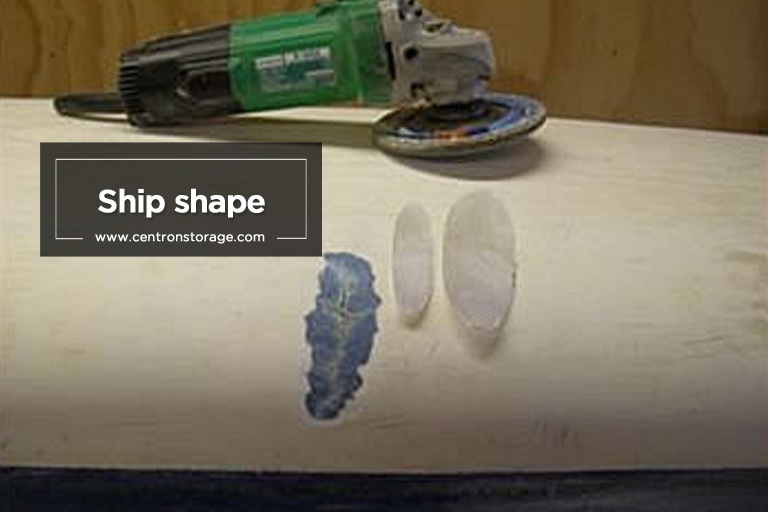 Credit: Maintenance | Q Kayaks
Credit: Maintenance | Q Kayaks
- Paddle boards, kayaks, and canoes
This is a great time to give your small pleasure crafts a good cleaning and inspect them for any damage.
- Start by washing your craft with hot, soapy water and then giving everything a once-over to check for damage or any needed repairs. Mark these areas with painters’ tape.
- You can polish out light scratches on fibreglass and kevlar canoes using an automotive paste cleaner and a light touch on a buffer. Be careful not to bear down too hard or you risk cutting into the furry kevlar below, which can’t be sanded.
- Store in a heated storage facility. This saves you the time you’d have to spend making sure your watercraft doesn’t warp or get damaged from being stored in below-freezing temperatures.
It’s a good idea to scrub down all your water toys (like boogie boards and other floaties) and let them dry thoroughly before placing into storage. This prevents mould growth and prolongs the lifespan of your equipment, saving you tons of cash that you’d have to spend on replacements.
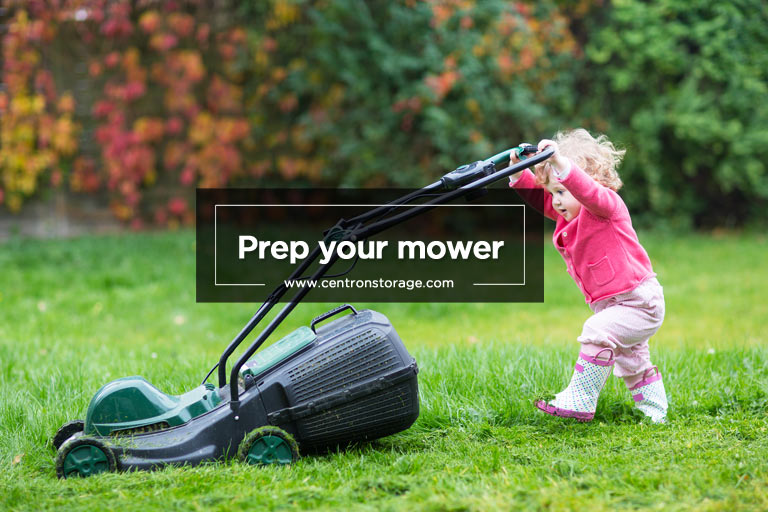
- Lawn Mowers:
Gas lawn mowers likewise take up valuable space that may be needed for your snowblower eventually. Before storing your gas lawn mower, there are a few things you can do to not only ensure it’s stored properly, but also so that it starts up in the spring with no problems.
To be safe, disconnect the spark plug before you proceed with any of the following:
- Drain the oil
- Remove the blade
- Clean the undercarriage
- Replace the spark plug: Even if the one you have is in good shape, a new spark plug is cheap and it’s nice to start the summer off with a new set up
- Change the air filter
Electric mowers are easier to deal with. Coil up the cord, clean the outside and flip it over, scraping out the inside. You may want to wrap it up in tarp as well, but if the plan is to put it in a secure, climate-controlled storage unit, it’s not necessary.

- Bikes
Bike shops are busiest in the spring; wait times for a tune up can sometimes be weeks. There is nothing sweeter than being able to ride on that first mild, snow-free day in April. The following tips will help:
- Give your bike a thorough cleaning. Remove all accoutrements such as your water bottle, cyclometer, and lights, and put them into a box marked “bike gear.”
- Take your bike to your mechanic (unless you’re handy that way) and get a full tune-up. In the autumn, this should be a day or two turn around.
- Ensure that the tires are at maximum pressure when you store your bike. Although they’ll deflate over the winter, this will help prevent flat spots or bulges from developing.
- Even though you just had it tuned up, add extra lubrication to the gears and cables. Even if it’s spending the winter in the climate-controlled comfort of Centron Self-storage, it won’t be ridden for several months, and this will add an extra layer of protection.
You can see how a little planning ahead and even less elbow grease can achieve a lot. Not only will you create space in your home’s storage areas for the fun things you’ll need over the winter, you’ll be totally ready for spring and summer. There’ll be little to do except retrieve your safely stored furniture, boats, mower, and bikes from storage and get right into the swim of things.
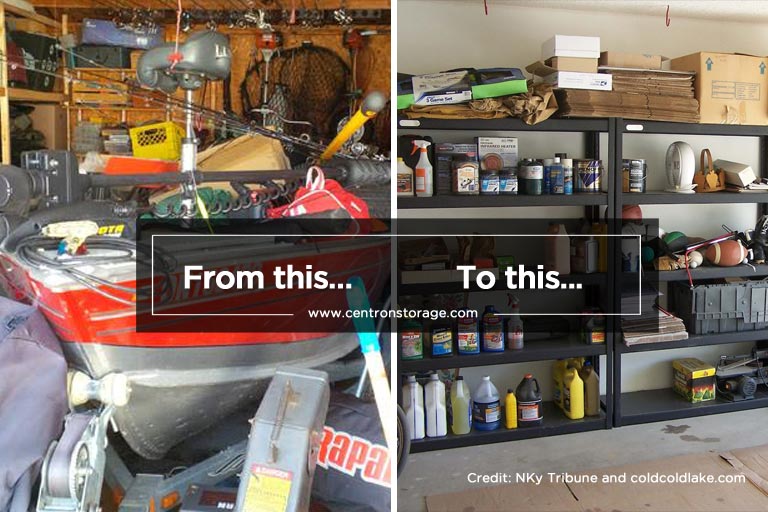
With over 30 years of experience and consistently high praise from our customers, Centron Self-Storage is the perfect solution for storing your summer stuff. Check out our storage calculator, book online and make things even easier! For storage in North York: (416) 739-0000.
11 Useful Tips for Storing Stuff for Winter
When storing your summer stuff for winter you’ll need to protect it, even if it’s going to into a clean, dry self-storage facility. The cold and lack of use of certain electronic devices and other items can inflict severe damage if they aren’t stored properly.
This is the second part of our autumn blogs reinforcing why prepping your items for storage is a good idea.
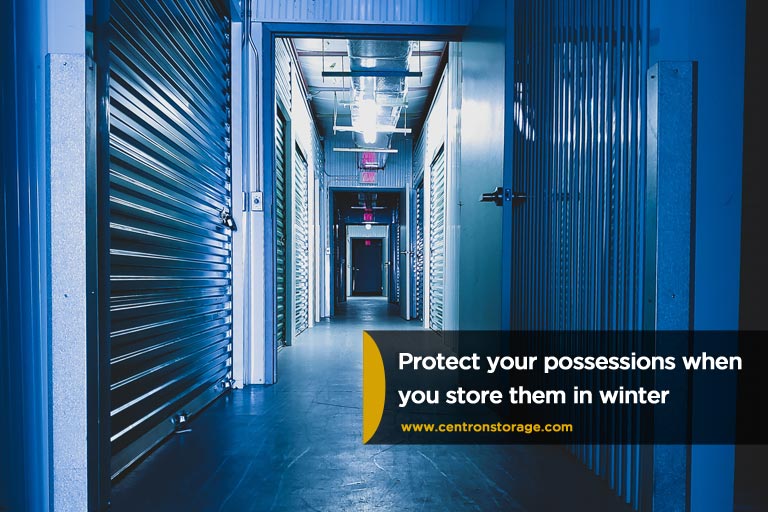
Cold and lack of use can hurt your belongings. Protect your treasured possessions by protecting them before winter storage. Use these helpful tips to prevent harm and keep your stuff in pristine condition. Start early so you have plenty of time to safeguard all the things you plan to store during the cold weather.
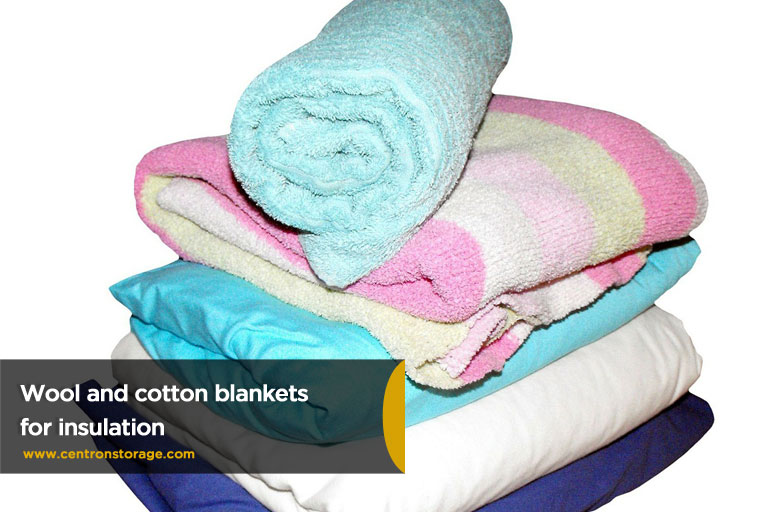
- Use wool or cotton covers – It’s a good idea to give your items added protection by packing them. This helps keep bugs and dust away, especially if they’re being stored long-term. However, avoid using vinyl or plastic covers; these materials trap moisture, which can cause damage to your items. The cold can also make plastic brittle, making it more likely to crack. Wrap your sensitive objects in wool or cotton (e.g. moving blankets) to insulate them. Alternatively, you can wrap certain items in newspaper to help retain heat.
- Clean your items – Always clean objects before putting them in storage. Dirty items can attract pests and it’s far more pleasant to take clean things out of storage than dirty. Give everything a thorough wipe, rinse, and dry — especially BBQ cooking utensils and tools. Rodents and other pests can smell any food residue, and those pests can cause damage to everything inside. Dirt and grime can also become a problem if they sit one or near fabric or paint for months on end. Clean everything preserves the life of your property.
- Repair everything – When you keep things in storage, it’s a good bet you won’t take them out until much later when you need them. If you pull something out of storage expecting to use it the same day, you may be disappointed. Check all your seasonal equipment and make sure it’s ready to use when you pull it out in springtime. You’ll have peace of mind all winter, knowing that your things were in good condition when you stored them.
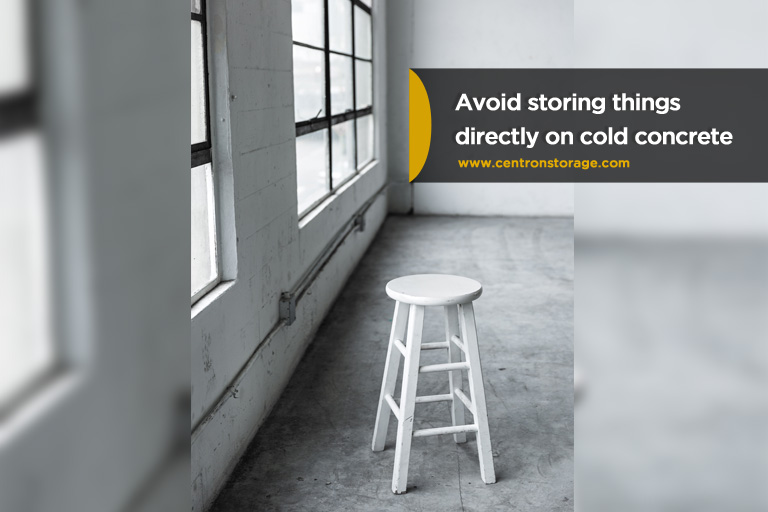
- Keep electronics off the ground – Be doubly careful if you’re storing any electronics and avoid setting them on the ground. The ground loses heat easily, making it colder than the rest of the room. The cold can affect electronics’ inner workings and batteries even in a climate-controlled storage unit. Electronics left like this over the winter can become quite damaged.
- Swap out your summer wardrobe – If you need some extra space in your closet, consider keeping your summer clothes in storage. Not only does this free up space for more appropriate clothing, you can also use this as an opportunity to find clothes you no longer want to keep and give them away. Likewise, you can do this with other summer stuff (e.g. surfboards, boogie boards, and beach toys). Keeping these items in self-storage is a good way to keep them safe.

- Store your lawn equipment – You won’t be doing certain chores during the winter (e.g. mowing the lawn). Use the off-season to store your lawnmower and other yard maintenance tools; they might take up space in the garage that could be better spent on winter-appropriate tools (e.g. shovels, salt, and snow blowers). Give your tools a good cleaning before storage to ensure they don’t get damaged while waiting. Remove all the gas from your lawnmower before storage. The gasoline can eat the carburetor, forcing you to have to repair it before use.
- Use your storage unit to hide gifts – Put your storage unit to good use by keeping Christmas presents and accessories there. If you have young kids, you can use this to play Santa and avoid them finding their presents before they should, keeping everything a surprise until the day itself. Keep all your gift-wrapping materials in the storage unit as well; now you have a place to keep them without making a mess at home.
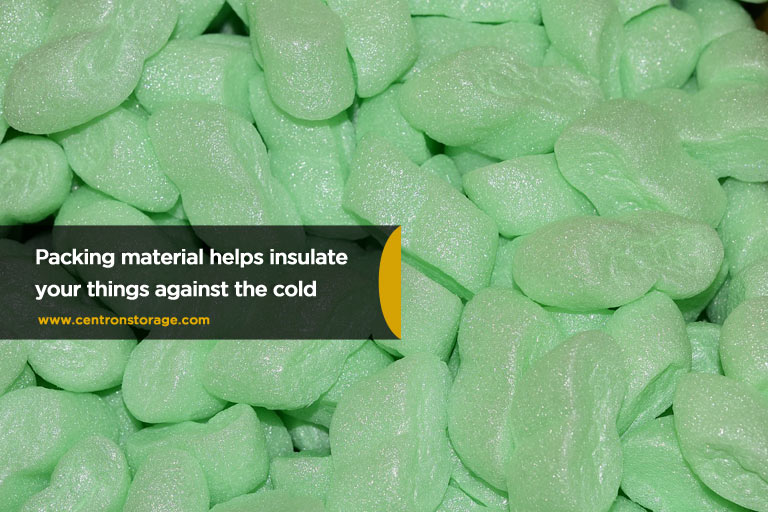
- Put in packing material – If you use boxes or other storage supplies, packing peanuts, and similar materials can do more than protect your stuff from impacts. Packing materials also work as insulators to protect your things from the cold, giving you greater security during winter. If you plan on keeping the storage unit for the long-term, consider using polystyrene peanuts to protect what you store for years to come.

- Be careful with canned goods – Be extra careful with canned goods, soda, or any other sealed items. The temperature difference can cause containers to burst and spill; the contents of those containers can be hazardous if consumed. Inspect any cans closely before use and look for any ruptures. If you have one, use an unplugged refrigerator to store these items. The fridge can keep your goods at a consistent temperature and insulate them from the cold.
- Protect your vehicle – Winter can be harsh on your vehicle, causing damage to the battery, brakes, and tires. If you have a car that’s specifically for summer driving, protecting it is important. To prepare it for storage in your garage or some other indoor location, empty the gas to avoid damaging the inner workings. Gasoline and chemicals in the engine can also freeze over the winter, causing compartments in the car to burst. Once spring comes, check the car’s tires; they tend to deflate during winter, so you may have to re-inflate them. Do be careful when inflating the tires. The expansion and sudden rise in temperature can cause blowouts. Measure the PSI before adding air. Check with your self-storage service first to find the right size unit for your vehicle.
- Choose climate-controlled units – When available, choose a storage service with climate-controlled units. These units keep a consistent temperature throughout the year, helping you avoid temperature damage. If you have sensitive items to store, this can be a worthy investment. Do note that climate-controlled units also work during summer to protect your things from the heat.
You will have to do some tasks to protect your belongings over the cold winter months, but it’s well worth the effort. These tips can help keep your items protected until you need them again. If you’re looking for safe and reliable storage, check out Centron Self Storage.
At Centron Self Storage, we want to help you find the right storage space. Whether you need to keep important documents, store your off-season items, or get ready for a move, we’re ready to serve you. Our staff can help you find the right unit size, and we offer content insurance to safeguard a unit’s content. Contact us at (416) 739-0000 in North York.
Make Way for Your “Word on the Street” Book Haul

Credit: thewordonthestreet.ca/Kuru Selvajarah
The Word on the Street Festival is coming. Along with the festival’s fully-packed itinerary of lectures, music, readings, and other fun events is an collection of books and magazines available for purchase. Whether you’re a collector, a bibliophile, or an avid reader, now is the time to consider viable storage options to house new reading acquisitions.
In 2018 The Word on the Street is celebrating its 29th festival on Sunday, September 23rd at Harbourfront Centre from 10 AM to 5 PM.
Celebrate the literary scene with prominent literary organizations and several of Canada’s best writers. Listen as local authors share their most riveting pieces; attend various workshops to learn from literary world influencers; participate in the numerous activities the festival has in store.
Browse the marketplace to discover new authors and titles or fall in love with your favourite authors’ latest works. Expand your collection; choose from a large selection of Canadian titles and take your pickings home with you, or to the nearest coffee shop!
(The question remains, though — where do you take your prized book collection when your tiny apartment shelves can no longer support it? — We have an answer for that later.)

Credit: thewordonthestreet.ca/Kuru Selvajarah
Here are a few useful tips to help you store books properly and some ideas to make room for a The Word on the Street book haul.
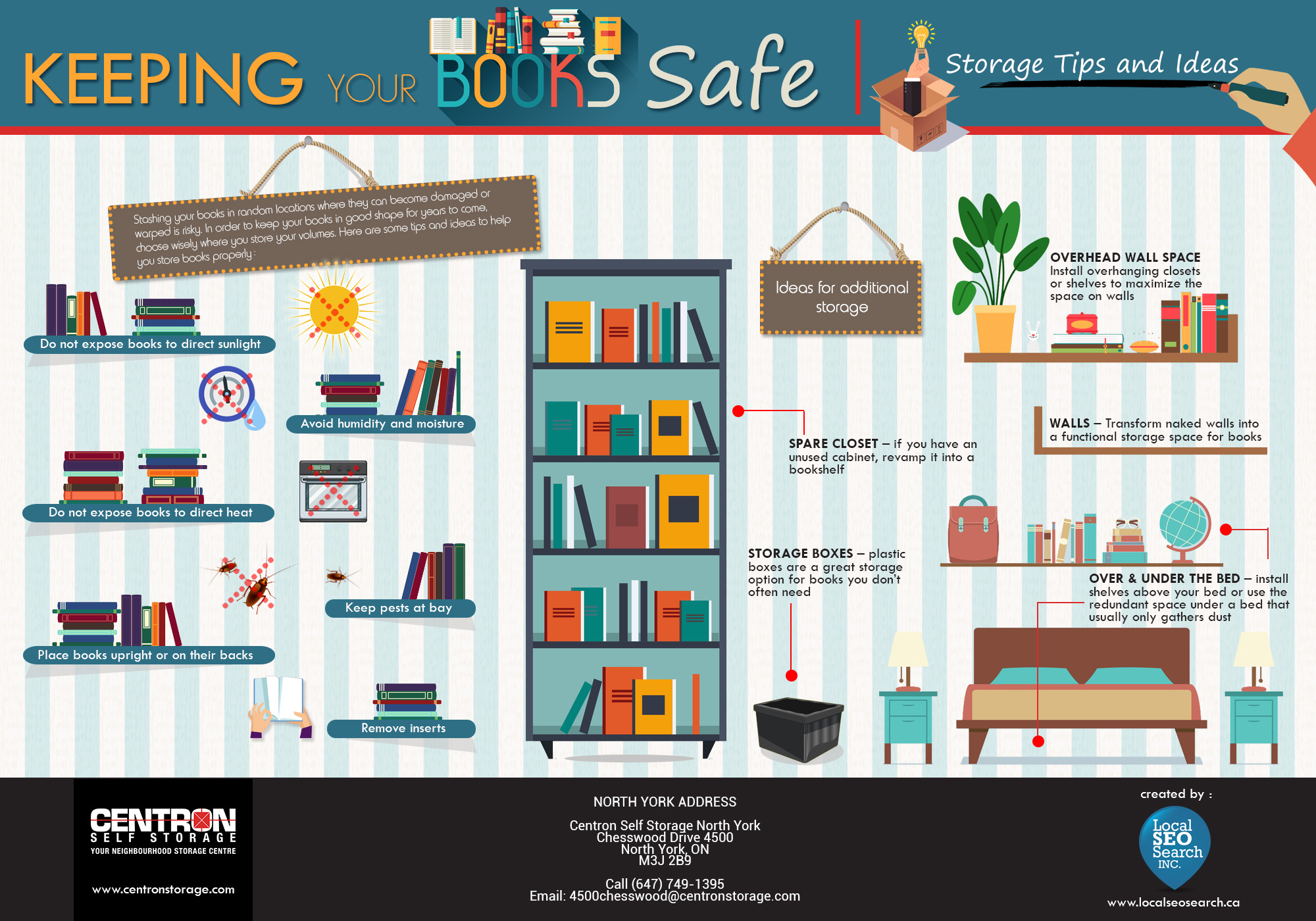
Storage Tips to Keep Your Books Safe
Stashing your books in random locations where they can become damaged or warped is risky business. Several factors will affect the condition of your books. If you want to keep them in good shape for years to come, choose wisely where you store your volumes.
- Do not expose books to direct sunlight. Sunlight is an enemy. It will cause colours on the book jacket, cover, and spine to fade. Sun exposure will also lead to premature wear and deterioration. Place your shelving units clear of windows and other high-sun areas.
- Avoid humidity and moisture. Ideal humidity is within a few degrees above or below 40 per cent. If there is too little moisture in the air, the pages and the bindings can dry, making books brittle and easily damaged. Excess moisture can lead to the growth of mould and premature aging of the pages (causing them to brown or develop yellow-brown spots). Never store books in an unfinished basement or attic with no temperature control.
- Do not expose books to direct heat. Besides sunlight, household items (e.g. heaters, appliances, and ducts) can radiate heat that can warp books and damage them. Make sure that the area where you choose to store your books is at room temperature (65 to 70 degrees Fahrenheit). If possible, store them in a climate-controlled environment.
- Keep pests at bay. One way of protecting books from pests (e.g. bookworms, silverfish, cockroaches, rodents) is to keep them in airtight containers. If this is not an option, keep food far from the storage area so insects, rats, and other intruders aren’t attracted to the area.

- Place books upright or on their backs. When the spine is on display you can easily see titles and find them when needed. Avoid storing books with the weak edges of the hardcover lying on the bottom of a shelf or storage box; this stresses the binding and causes damage. If you must store them this way, place the spine at the bottom.
- Remove inserts. Before storage, make sure your books are free of bookmarks or other inserts that may cause eventual damage.
Ideas for Additional Storage
Standard bookshelves may be a staple when it comes to assembling a personal library. However, you can only fit so many of them in your home, especially if you live in a tight space. If you have no room for shelves but want to expand your collection, consider these tips:

- Walls – Transform naked walls into a functional storage space for books. Spruce them up with decorative hanging baskets you can fill with novels and paperbacks — a practical and aesthetically pleasing storage option. You can replace your existing wall decor with floor-to-ceiling shelves, using books as decorative piece to accent a wall (instead of a wallpaper or picture frames).
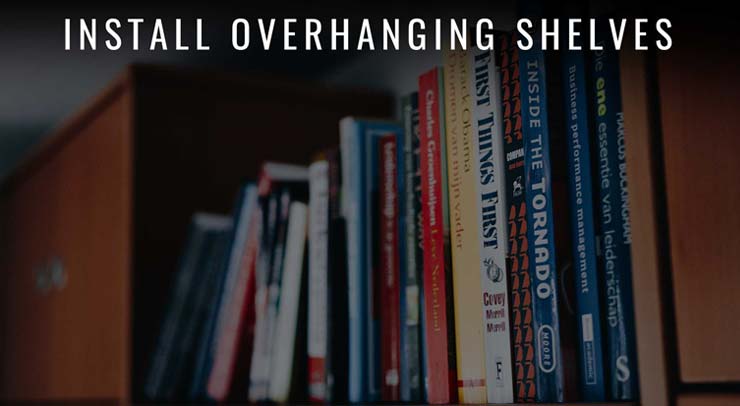
- Overhead Wall Space – Chances are there is a significant amount of unused space near your home’s ceiling. Install overhanging closets or shelves to maximize the space on walls.
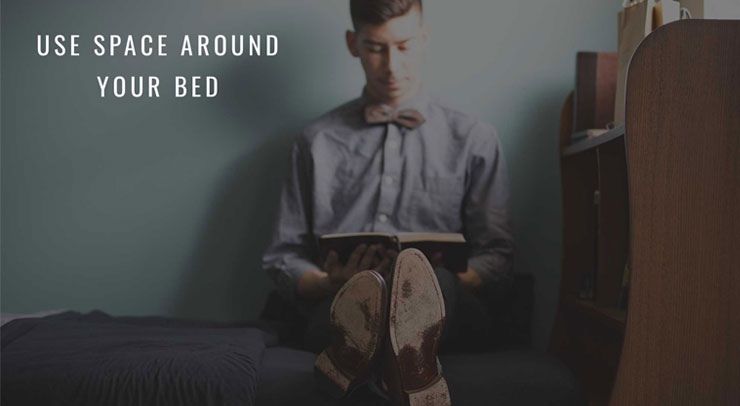
- Over and Under the Bed – Install shelves above your bed (in place of a headboard) or use the redundant space under a bed that usually only gathers dust. With this setup, you maximize bedroom space and provide easy access to the book/s you are currently reading or favourite titles.
- Spare Closet – If you have an unused cabinet (or one filled with items you were planning to discard anyway), revamp it into a bookshelf. You can also build shelves and install lighting fixtures for better visibility when scanning for titles. You can also turn it into a display case for all your favourite titles by replacing the wooden door with glass.
- Chairs – If your chair, ottoman, or stool comes with a detachable lid, use it to keep your books out of site, but easily accessible when you need them. You can also use an attractive, flat-topped trunk as a coffee table and store books inside.
- Storage Boxes – Plastic boxes are a great storage option for books you don’t often need. Sturdy plastic boxes keep protect them from sunlight, moisture, insects, and rodents. Purchase stackable ones so you can easily place them on top of each other for easy storage. Do not store your books in cardboard boxes for long periods of time; they attract moisture, mould, and pests.

Credit: thewordonthestreet.ca/Kristina Goltsis
Don’t let the lack of storage space keep you from expressing your love for the literary arts. Make way for new acquisitions and give old ones a safe and secure space. If you’ve run out of storage space and need a temporary — or permanent — solution for your prized possessions, call a reputable storage facilty in your area. They can offer a safe place to store your books.
Call Centron Self Storage at (416) 739-0000. We offer self-storage units in North York, the services of fully-trained staff, cutting edge storage technology, and 24/7 access and security. Choose from the variety of unit sizes we have available.
